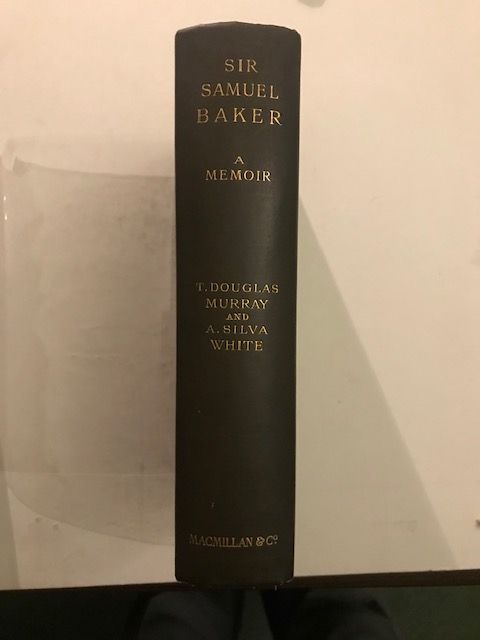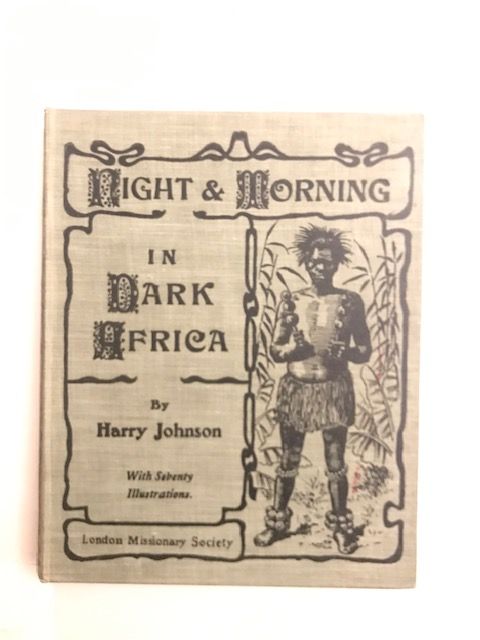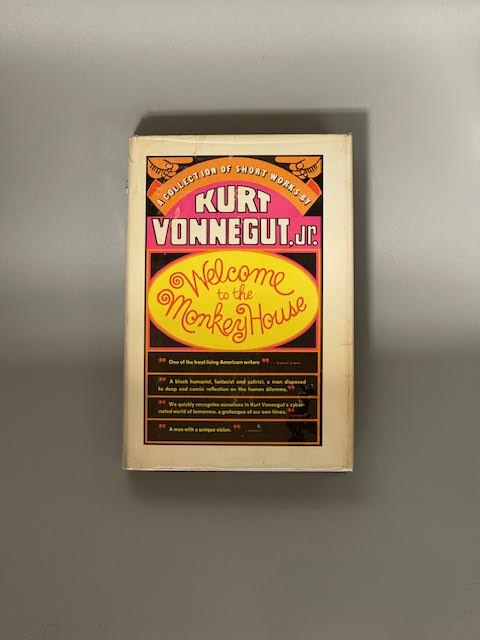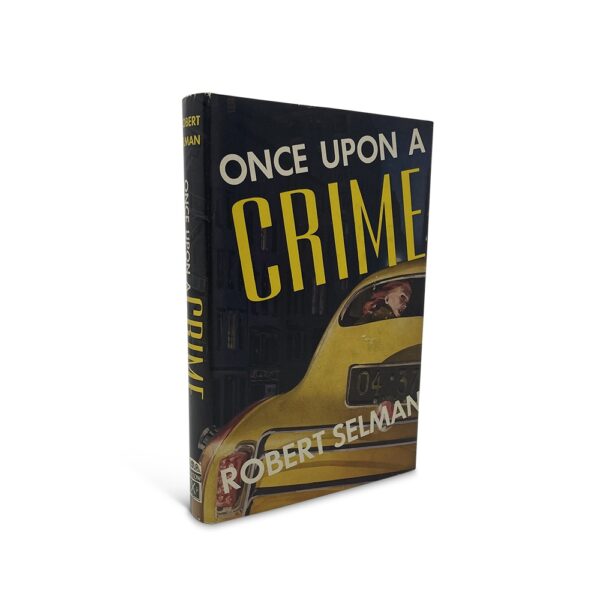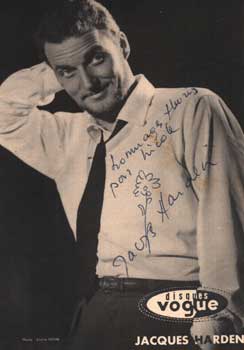
Encyclopedie Automobile
SATIRICAL LITHOGRAPHS OF EARLY FRENCH CARSEncyclopédie Automobile: La Belle Epoque et Les Pionniers de L'Automoile. Illustrated with 16 original color lithographs by Guy Sabran. Oblong Folio. Original pictorial olive green folding cover; title in a frame representing the entrance to the Parisian metro station. Guimard, Champrosay, Editeur, Paris, 1956. First Edition.Loose illustrations, as issued, inserted in folding cover. A wonderful series of color lithographs satirizing early French car culture. Illustrations are: Coupé de Ville Renault 1905; Zèbre 1904; Double Phaéton Morse 1903; Double Phaéton Delaunay-Belleville 1911; Landaulet d'Amédée Bollée 1878; Phaéton Panhard Levassor 1891; Léger George Richard 1893; Peugeot Grand Luxe 1895; Delahaye 1897; Le Petit Phaéton Renault 1898; Cabriolet Chenard et Walker 1904; Le Phaéton Bardon 1899; LA "Jamais Contente" de Jenatzy 1899; Phaéton Grand Sport Panhard 1899; - La Limousine de Ville de Léon Bollée 1899; Taxi Renault 1905. Covers slightly soiled; spine and corners worn; some slight warping to a few lithographs; some with tape at corners, having been crudely hung, not in any way damaging the images; o/w bright and clean.- $275
- $275
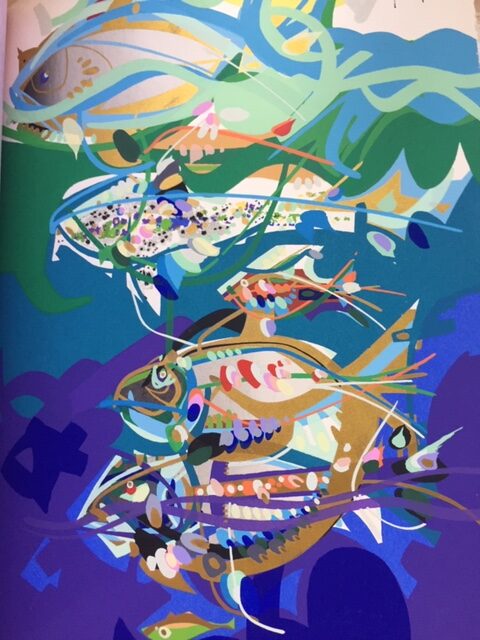
Le Bateau Ivre. (The Drunken Boat).
Illustrated with 36 color plates and text manuscript by Raymond Moretti. Folio. Cream-colored vellum binding, with Moretti illustration on cover; enclosed in ¼-leather-backed marbled board box, with vellum spine label. Chez Joseph Pardo à l'enseign du Sefer, Nice (1966). One of 350 copies on vellum pure rag, with an extra suite of 11 full-page color plates on Japan paper. Copy #298, dedicated and signed by Moretti. Laid-in is a "Certificat de Garantie" from Joseph Pardo. Spine of box chipped and frayed; edges chipped; book in fine condition, with clean, bright pages and plates. Rare- $2,750
- $2,750
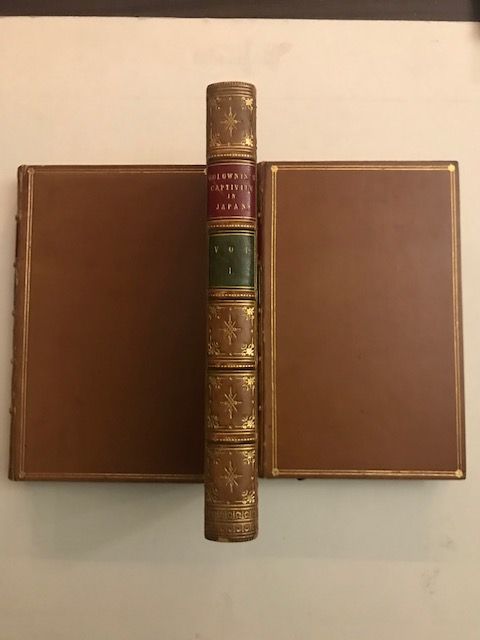
MEMOIRS OF A CAPTIVITY IN JAPAN during the Years 1811, 1812 and 1813, with observations on the country and the people.
GOLOWNIN Vasili. Second Edition, 3 vols, pp lv, lxxxiv, 315; 356; (ii), viii, 302; contemporary tan calf, aeg, near fine. First Edition to have all 3 volumes printed at the same time.- $1,960
- $1,960
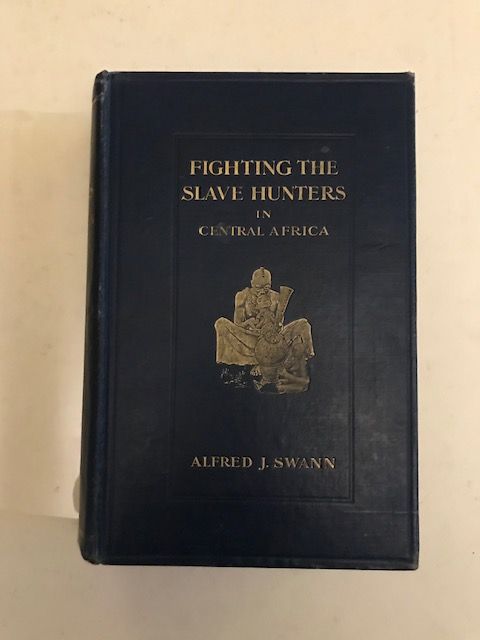
FIGHTING THE SLAVE-HUNTERS IN CENTRAL AFRICA; a Record of Twenty-Six Years of Travel and Adventure round the Great Lakes and of the Overthrow of Tip-Pu-Tib, Rumaliza and other great Slave-Traders.
SWANN Alfred J. FIRST EDITION, large 8vo, pp 359, folding map, frontispiece, illustrations, original blue cloth, gilt vignette, excellent.- $509
- $509
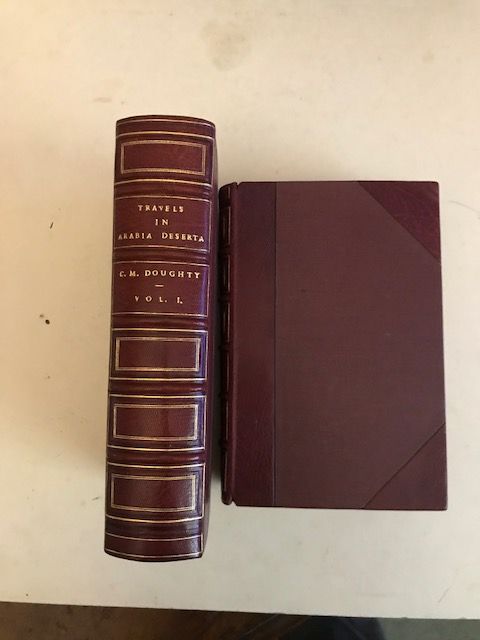
TRAVELS IN ARABIA DESERTA.
DOUGHTY Charles M. FIRST EDITION, 2 vols, 8vo, pp xx, 619, [4] appendix, advertisements; xiv, 539, [3] appendix, 543-690 Index and Glossary of Arabic Words; folding map in pocket of lower cover Vol 1, dissected and laid on linen as issued, numerous illustrations (4 folding), recent red/brown half morocco, small round library stamp on verso of title-page, text clean.- $2,547
- $2,547
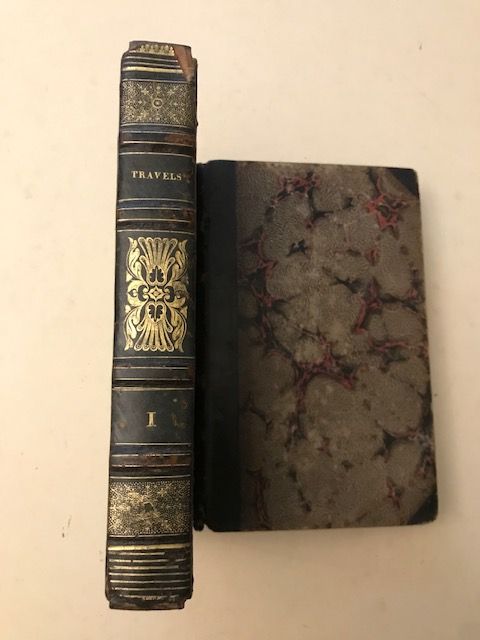
TRAVELS IN TURKEY, EGYPT, NUBIA, AND PALESTINE; in 1824, 1825, 1826, and 1827.
MADDEN Richard R. FIRST EDITION, 2 vols, 8vo, pp xvi, 401; viii, 398; hand-coloured frontispiece (author in Syrian costume), contemporary green half calf, some wear to head and tail of spine, very good and clean. "The author compares his letters to those of Lady Mary Wortley Montagu and discusses the difficulty of combining accurate observations with literary elegance: 'the refinement of her enthusiasm prevailed over the correctness of her descriptions'. Madden had trained as a surgeon, though he never practised in England, but because of this he was able to enter areas closed to most Europeans, mainly the harem and some slave bazaars. He travelled in the Levant from 1824-27. His work also contains much information on Egypt and Egyptology." Blackmer Blackmer 1056; not in Abbey- $751
- $751
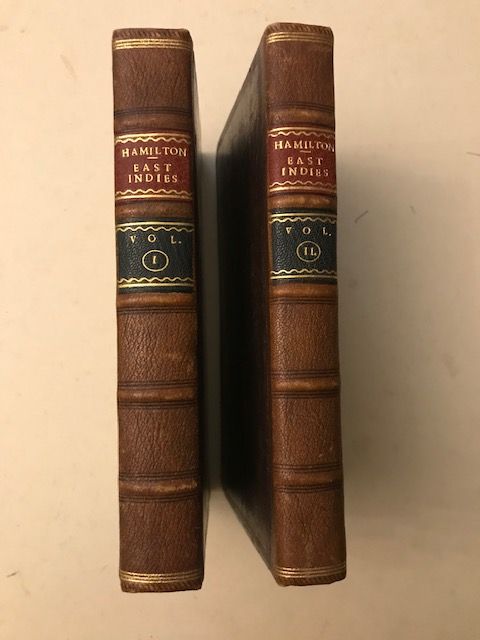
A NEW ACCOUNT OF THE EAST INDIES; Giving an Exact and Copious Description of the Situation, Product, Manufactures, Laws, Customs, Religion, Trade, etc of all the Countries and Islands, which lie between the Cape of Good Hope and the Island of Japan.
HAMILTON Alexander. Second Edition, 2 vols, 8vo, pp xxix, ix, 396; xii, 309, 10: 8 folding engraved maps (1 map with small tear in fold), 11 plates, some slight browning, contemporary brown calf, recently re-backed. Hamilton went to sea, in his own words: "very young", in 1688 and travelled as far as the Barbary coast before basing himself in Surat and trading and travelling all over the Indian Ocean. He made a reputation for himself as a foul-mouthed, resourceful and bold operator fending off Baluchi robbers, treacherous governors and Indian pirates. Goldsmiths 6522; Cordier 890; Mendelssohn (1979) II, 492- $4,572
- $4,572
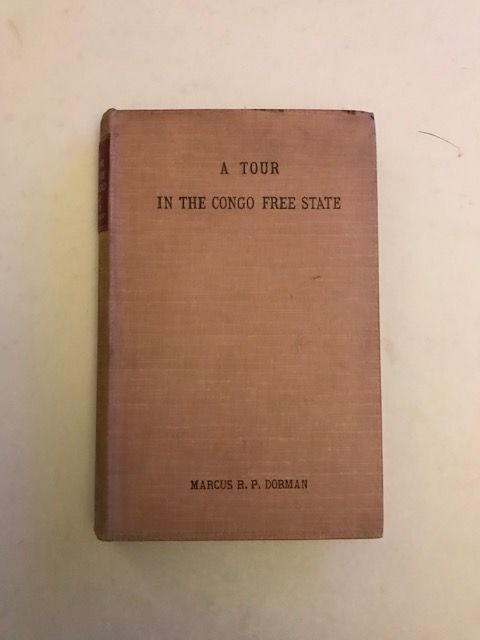
A JOURNAL OF A TOUR IN THE CONGO FREE STATE.
DORMAN Marcus R P. FIRST EDITION, 8vo, pp viii, 192, map, plates, original beige cloth, recent red morocco label, scarce. The author was an adventurer who decided to travel around the Congo. He found the people hospitable and kind. He did some hunting during the trip, and left the Congo having much admiration for the country.- $588
- $588
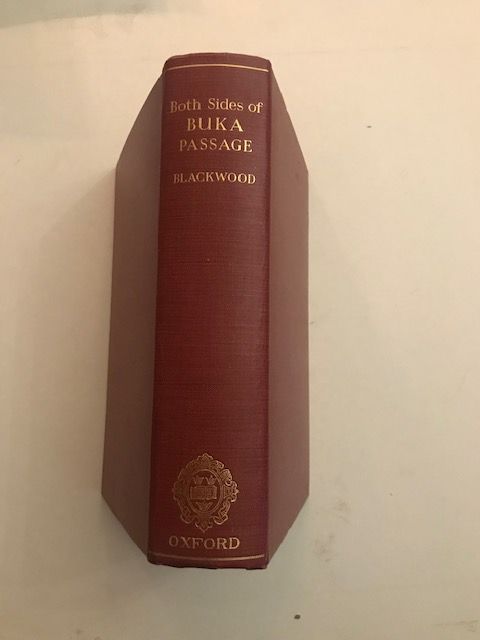
BOTH SIDES OF BUKA PASSAGE; an Ethnographic Study of Social, Sexual, and Economic Questions in the North-Western Solomon Islands.
BLACKWOOD Beatrice. FIRST EDITION, 8vo, pp xxiii, 624, 80 plates, map, tables, illustrations, original red cloth, light staining to top edge, dust-jacket (very good), clean.- $457
- $457

SIX MONTHS AT THE CAPE or Letters to Periwinkle from South Africa
Ballantyne, R. M. Ballantyne, R[obert] M[ichael]. SIX MONTHS AT THE CAPE or Letters to Periwinkle from South Africa. With 12 illustrations by S. E. Waller (from sketches by the author). London: James Nisbet & Co., 1879. First Edition. 8pp Nisbet catalogue at rear. A Very Good example of this apparently scarce title, minor wear to the extremities, a firm copy retaining excellent eye appeal. Contemporary owner's ink signature and tiny smudge to ffep. Set in the colony of South Africa and based on Ballantyne's personal experience there, this tale is filled with the author's usual geographic delights. He takes particular relish in the description of an Ostrich hunt (as depicted in gilt on the front cover).- $250
- $250
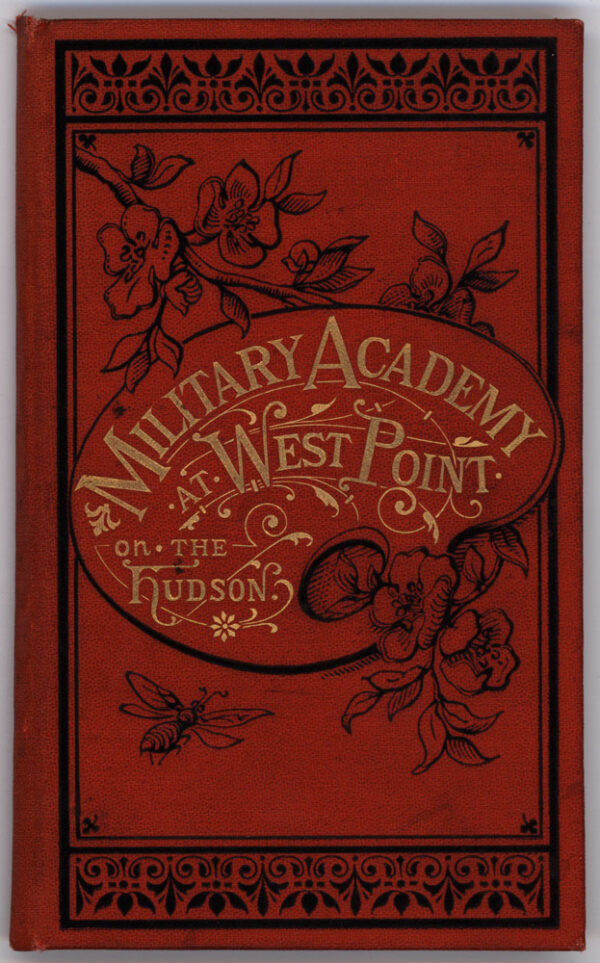
Military Academy at West Point on the Hudson
Glaser, Louis Hardcover. 24mo (5.5" 3.25"), red cloth, stamped in black and gold. Accordion strip, 19 lithographic plates. Three page catalog of Witteman Bros. souvenir albums pasted in at rear. CONDITION: Very good, first plate partially detached from inside of front cover. A souvenir album of views of the Military Academy at West Point on the Hudson, showing the parade ground, barracks, and other such scenes.- $125
- $125

Southwest Louisiana on the Line of the Southern Pacific Company
Knapp, S. A., et al. 8vo (9" x 6"), printed tan wrappers. 71, [2] pp., illus. Faded agent stamp on front wrapper. CONDITION: Very good, re-backed, chips to edges of wrappers neatly filled in, one minor stain on p. 37. An appealing pamphlet picturing and detailing Southwest Louisiana for the prospective settler and capitalist. The text offers a full description of Southwest Louisiana along the line of the Southern Pacific Railroad, where some 10,000 Northerners have located homes. Covered here is the production of sugar; fruit growing (several letters concerning fruit growing in the state are reproduced); truck farming; the climate and its "advantages," and the cultivation of rice on the prairies (including a list of rice planters in the area and the number of acres they own). Also detailed are Southwest Louisiana's grasses, machinery, "safe and profitable investments," Lake Charles College, feed for stock ("the problem of cheap feed for stock"), value and price of land, Southern homes, Joseph Jefferson's Orange Island (near New Iberia), the abundant plant Palmetto, cotton, timber, Lake Charles, minerals, topography, roads, water, and insects. A number of Louisiana regions are described, including Welsh, Jennings, Lake Arthur, Shell Beach, Acadia Parish, La Fayette, Vermillion Parish, and Jeanerette. The text concludes with a note on choice lands in Texas by a land commissioner in Houston. The illustrations show sugar cane fields, a pear orchard, an orange grove, residences and families, scenes of laborers harvesting, threshing, and shipping rice, a stock farm, a live oak tree, black workers in cotton fields, a tramway transporting lumber, and a rice flume. The map, entitled "Map of Southwestern Louisiana," shows the Southern Louisiana Railroad extending from New Orleans into Texas. Promoted on the verso of the front wrapper is the Southern Pacific Company's "Sunset Route."- $475
- $475
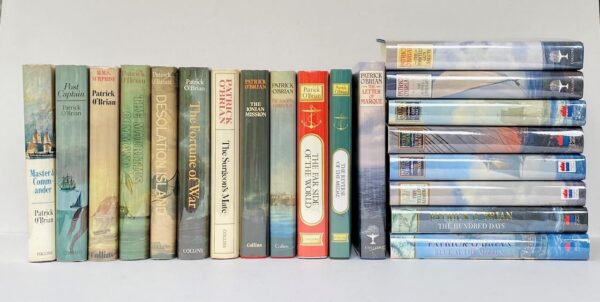
Complete set of Jack Aubrey & Stephen Maturin novels [The Far Side of the World is unclipped; two volumes SIGNED by the Author, most books and jackets in Fine condition]
O'BRIAN, Patrick Twenty Volumes, all are First edition, First impressions. Octavos, bound in cloth covered hard boards and in the original publisher's dust jackets. Overall this is a very pretty, bright and clean set, with most of the books and jackets in fine condition. The Far Side of the World has its original publisher's printed price (£8.95 net) present to the front flap. Clarissa Oakes and The Commodore are both SIGNED by the Author. None of the books have any previous owner names, inscriptions, bookplates or other markings. Comprises the following: Master and Commander - Very Good book (spotting to edges) in a Near Fine unfaded dust jacket; Post Captain - Fine book in Fine dust jacket; HMS Surprise - VG+ book in VG+ dust jacket, which is unfaded to the spine, but has a short closed tear to the rear panel; The Mauritius Command - VG+ book (small mark to ffep) in Near Fine dust jacket (slight fade to spine); Desolation Island - Fine condition book in Fine dust jacket; The Fortune of War - Fine condition book in Fine dust jacket (no fade to spine); The Surgeon's Mate - Near Fine book in Near Fine jacket; The Ionian Mission - Fine condition book in dust jacket which has been clipped and has a publisher's price sticker (£7.95). Jacket has none of the usually found spine fade and grades Fine other than for the clip; Treason's Harbour - Fine book in Fine dust jacket. Beautiful, as new, copy; The Far Side of The World - Fine condition book in Fine unclipped jacket (£8.95 net). Paper not toned as often found and jacket has no spine fade; The Reverse of the Medal - Fine condition book in Fine dust jacket; The Letter of Marque - Fine condition book in Fine dust jacket; The Thirteen Gun Salute - Fine condition book in Fine dust jacket. The jacket is unclipped, unpriced and has a publisher's price sticker on the flap (£11.95); The Nutmeg of Consolation - Fine condition book in Fine dust jacket; Clarissa Oakes - Fine condition book in Fine dust jacket. SIGNED by the Author to the title page. Laid in is a folding card promoting "An Evening with Patrick O'Brian at the Boston Atheneum, 12 November 1993"; The Wine Dark Sea - Fine condition book in Fine dust jacket which is unclipped but unpriced; The Commodore - Near Fine book, which is a little tanning to the paper in Fine condition dust jacket. SIGNED to the title page by the Author; The Yellow Admiral - Fine condition book in Fine dust jacket; The Hundred Days - Fine condition book in Fine dust jacket; Blue at the Mizzen - Fine condition book in Fine dust jacket.- $8,883
- $8,883
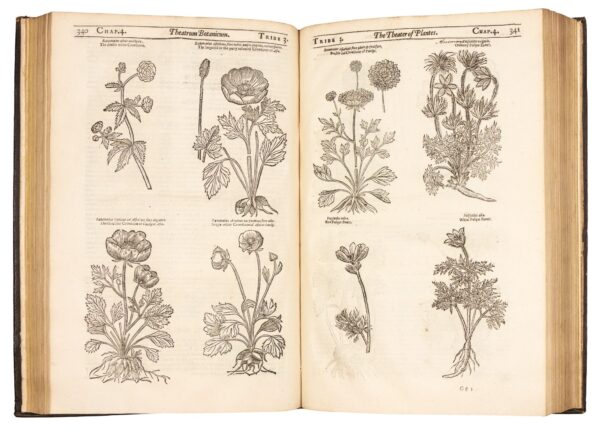
Theatrum Botanicum: The theater of plants.: Or, An herball of a large extent: containing therein a more ample and exact history and declaration of the physicall herbs and plants that are in other authours, encreased by the accesse of many hundreds of new, rare, and strange plants from all the parts of the world, with sundry gummes, and other physicall materials, than hath beene hitherto published by any before; and a most large demonstration of their natures and vertues. Shevving vvithall the many errors, differences, and oversights of sundry authors that have formerly written of them; and a certaine confidence, or most probable conjecture of the true and genuine herbes and plants. Distributed into sundry classes or tribes, for the more eas
HERBALS. BOTANY. MEDICINE. Parkinson, John (1567-1650) Illustrated with an additional, pictorial title page engraved by William Marshall (fl. 1617-1650) and 2716 woodcuts of plants. Bound in fine late seventeenth-century black morocco, paneled gilt, with a central lozenge featuring acorns and large scrolling tools at the corners, spine gilt in compartments, gilt red morocco labels, endcaps neatly restored, the leather along the hinges worn. Complete with the terminal errata leaf; bifolium 4C3-4 apparently supplied to rectify a binding error in which lvs. 4C2 and 4C5 were bound in twice (manuscript note to that effect); eighteenth- or early 19th century ownership inscription to each volume of "R. James", with scattered annotations in his hand throughout (adding Latin names and some cross-references). Clean marginal tears (no loss) to lvs. F4, Ttt5, and 5G6; clean tear in text (no loss) to leaf Vvv5. A handful of leaves lightly toned; occ. rust spots (with one tiny hole on leaf Nn4 and another on leaf Nnnn6; slightly larger rust holes on 6R4-6, one on each leaf). Nnnn5, Vvvv5-6 marginal dampstain. Second volume with some light toning and some shine-through from the woodcuts. The gardener and apothecary John Parkinson (1567-1650) received the title of Royal Apothecary from King James I. Later, Charles I appointed him as his chief botanist. "Throughout his long working life, John Parkinson earned his living and reputation as an apothecary, preparing and dispensing plant-based and other medicines from his shop on Ludgate Hill, as well as growing and cultivating the plants that were the essential tools of his trade on a substantial plot in Long Acre near Covent Garden, further outside the London city walls to the west."(Jill Francis, John Parkinson: Gardener and Apothecary of London, p. 229) "Parkinson's 'Theatrum' was the largest herbal in English to date; it was also the last great medicinally-based plant study, by an author who thought of himself as first and foremost an apothecary. Altogether 2,716 woodblocks were individually cut for this massive herbal, which describes more than 4,000 plants, most of them with medicinal properties. Parkinson had given notice of his intention to compile an herbal in his 'Paradisi in sole Paradisus terrestris' of 1629, but was delayed by the publication of the second Johnson edition of 'Gerard's Herball' in 1636. This delay meant that Parkinson's work had time to grow much larger than originally planned, and on publication it included about 1,000 more plants than Gerard's, and describes many species not previously recorded."(Tomasi, Oak Spring Flora, p. 160) "[The herbal] was a monumental work drawing on Parkinson's 50 years of experience of growing and working with plants. Although working within a traditional genre, Parkinson's great herbal was firmly rooted in the new empirical methods of scientific observation and experiment. "According to Parkinson, [earlier writers of herbals, such as William Turner] presumed a knowledge of the new plants arriving from overseas - often as little more than seeds, roots or dried specimens -but they cannot possibly have understood or seen for themselves the nature of the plant. As he writes elsewhere, 'some of these errors are ancient, and continued by long tradition, and others are of later invention, and therefore more to be condemned'. Parkinson, on the other hand, actually took the seeds, bulbs and roots and planted them in his own garden in Long Acre to observe how they grew and what they looked like. Some he received via fellow gardeners: for instance, his friend John Tradescant sent him a root of Indian Moly to plant in his garden. On another occasion, in 1608, Parkinson commissioned the plant hunter William Boel to seek out for him new species of plants while travelling in Spain and he returned with over 200 different kinds of seeds. Parkinson wrote that 'by sowing them [I] saw the faces of a great many excellent plants'. It was in this way, by careful scientific method, that he built up his extensive kno- $18,000
- $18,000

Lucubrationes, ab innumeris mendis repurgatae. Utopiae libri II. Progymnasmata. Epigrammata. Ex Lucinao conversa quaedam. Declamatio Lucianicae respondens. Epistolae. Quibus additae sunt duae aliorum Epistolae, de vita, moribus & morte Mori
More, Thomas, Saint (1478-1535) With the woodcut illustration of the island of Utopia. A fine copy in 16th c. English calf (re-cased, small repairs, later gold lettering on spine, endpapers renewed. One of the original pastedowns- the leaf from an early English almanac -is visible on the inner rear board.) An excellent copy, the vast majority of the text very fresh, with just some very minor faults: inner margin of title page repaired (far from the text), light stain along top blank edge of first 4 lvs, slight marginal fraying to first 3 lvs., small stain on leaf p8, very light dampstain to the final three gatherings, very small marginal tears to final 3 lvs. The woodcut illustration of the Island of Utopia is on leaf d3. Printer's device on final leaf, verso. Bookplate: "William Salkeld, Esq.", possibly the Serjeant-at-law and law reporter of that name (1671-1715). First edition of the collected Latin works of Sir Thomas More, including the "Utopia" illustrated with a full-page woodcut map. Among the letters published here for the first time is a letter to Martin Dorpius in which More defends Erasmus' translation of the New Testament from the Greek, thus clearly siding with the enlightened "new learning". It also contains a letter from Erasmus to Ulrich von Hutten which contains details of More's physical appearance. There are 9 letters from More to Erasmus, 1 of which concerns the portrait that Erasmus sent to More so that he could always be with him (See "Gifts for an absent friend" below.) The full-page illustration of the Island of Utopia is based on Ambrosius Holbein's woodcut from the 1518 Froben edition. "Utopia" begins with More's encounter with Raphael Hythloday (whose name means 'teller of tall tales'), a traveler who has just returned from voyages with Amerigo Vespucci. Hythloday tells More of a distant island called Utopia, where all property is held in common ownership, where six hours a day are devoted to work and the rest to recreation, where gold and silver are used not as currency but as the material for making shackles and chamber pots, and slaves (criminals and prisoners of war) are treated fairly. In its geography and topography, the island bears a striking resemblance to England. There are fifty-four city-states on the island, perhaps mirroring the number of shires in England and Wales (plus London) in More's time, and all are identical in languages, customs, and laws and similar in size, layout, and appearance. "More positioned his country somewhere in the New World (or, at least beyond the limits of the currently known world), for he states that his narrator, Raphael Hythlodaeus, participated in the last three of Amerigo Vespucci's four voyages. On the final voyage, Hythlodaeus did not come home with Vespucci; rather, he continued his explorations and ultimately discovered Utopia, where he lived for five years before, miraculously, returning to Europe on a Portuguese vessel. Hythlodaeus's descriptions of his residence in Utopia provide the heart of the piece."(Delaney) Gifts for an absent friend: The Portraits of Erasmus and Gillis: The volume also includes Thomas More's letters to Peter Gillis (in whose garden More had conceived of the "Utopia") and Erasmus, in which he thanks his friends for the portraits of themselves that they had sent to More as gifts. The two men had commissioned the leading Antwerp painter of the day, Quentin Matsys, to paint the two portraits as a dyptich. The idea behind the gift being that, through these portraits, Erasmus and Gillis could always be close to their friend. More received the paintings in October 1517 at Calais (where he was on embassy for Henry VIII.) "More wrote from Calais to thank each donor, asking each to show his letter to the other. He surely took his new treasure with him when he returned to London in December. More's letter to Erasmus acknowledges receipt of the diptych (tabula duplex), praises the artist's handiwork and rejoices at his own good luck in having such friends. His letter- $16,000
- $16,000

Phonurgia Nova sive Conjugium mechanico-physicum artis & naturae paranympha phonosophia concinnatum. quâ universa sonorum natura, proprietas, vires effectuúm[que] prodigiosorum causæ, novâ & multiplici experimentorum exhibitione enucleantur : instrumentorum acusticorum, machinarúm[que] ad naturæ prototypon adaptandarum, tum ad sonos ad remotissima spatia propagandos, tum in abditis domorum recessibus per occultioris ingenii machinamenta clam palámue sermocinandi modus & ratio traditur, tum denique in bellorum tumultibus singurlaris hujusmodi organorum usus, & praxis per nouam phonologiam describitur
ACOUSTICS. PHYSICS. Kircher, Athanasius (1602-1680) Bound in contemporary stiff vellum (small repairs to foot of the spine, re-cased, endpapers renewed.) Internally, this copy is in fine condition with only minor faults as follows: half-title soiled, small wormholes in first four lvs., a peppering of small wormholes to final four index lvs. and final blank leaf. Marginal hole (not affecting text) to leaf B3, margins of portrait leaf foxed and with light stain at foot. The volume was re-cased, probably to remove a second, slim work (judging by the size of the overlapping vellum fore-edges of the binding.) Provenance: Engraved armorial bookplate of Augustin Erath (1648-1719), German Augustinian Canon, theologian, translator. The "Phonurgia" is illustrated with an added engraved allegorical title by Georg Andreas Wolfgang (1631-1716) after Felix Cheurier, an engraved title vignette, an engraved portrait of Emperor Leopold I by Wolfgang after Franz Herman, two engraved plates, seventeen engravings and numerous woodcut diagrams and illustrations in the text, musical notation, ornamental woodcut head- and tail-pieces, and decorative initials. Among the illustrations are Michele Todini's "claviorganum" (one of the most technologically advanced keyboards of Kircher's time), Kircher's own musical invention, the "Aeolian Harp", and the invention that inspired the book, Kircher's "Speaking Trumpet" (the megaphone), shown at the shrine of St. Eustace in Monterella. Various chambers with peculiar acoustical properties are also depicted, such as a Vitruvian amphitheater, the courtyard at the Villa Simonetta in Milan and the "ears" of the Tyrant Dionysius of Syracuse. There is also a depiction of one of Kircher's "talking statues", his 17th century intercom. "The 'Phonurgia Nova' is, in part, Kircher's response to Sir Samuel Morland (1625-95), a fellow of the Royal Society of London, who claimed.to have invented the megaphone. Numerous testimonies from Kircher's admirers, such as James Alban Gibbs and Gaspar Schott, are appended to the work defending Kircher's claim as the inventor of the tuba stentorophonica, as Morland called it. Kircher had indeed written extensively on the device in his 'Musurgia' and had been using the 'speaking trumpet' for years at the shrine of Mentorella to call people to services. The 'Phonurgia' treats the science and applications of sound amplification and echoes. It was the first book published in Europe devoted entirely to acoustics." (Merrill). "The importance that the Jesuits placed on sensory experience as part of worship had a significant impact on Kircher's treatment of music. Within the devotional framework, music was valued precisely because of its capacity to move the passions, to produce strong emotional effects that under properly controlled conditions were designed to ravish the soul and lead the faithful closer to the divine. Indeed, Kircher declared that the goal of all music was to move the affections, and this belief goes a long way toward explaining his interest in classifying all the various emotional or affective states that music can imitate. Kircher's was the first systematic account of the 'doctrine of affections' which underpinned early opera and oratorio, and was one of the fundamental assumptions of later Baroque composers such as Bach and Handel."(Penelope Gouk, "Making Music, Making Knowledge: The Harmonious Universe of Athanasius Kircher").- $15,000
- $15,000
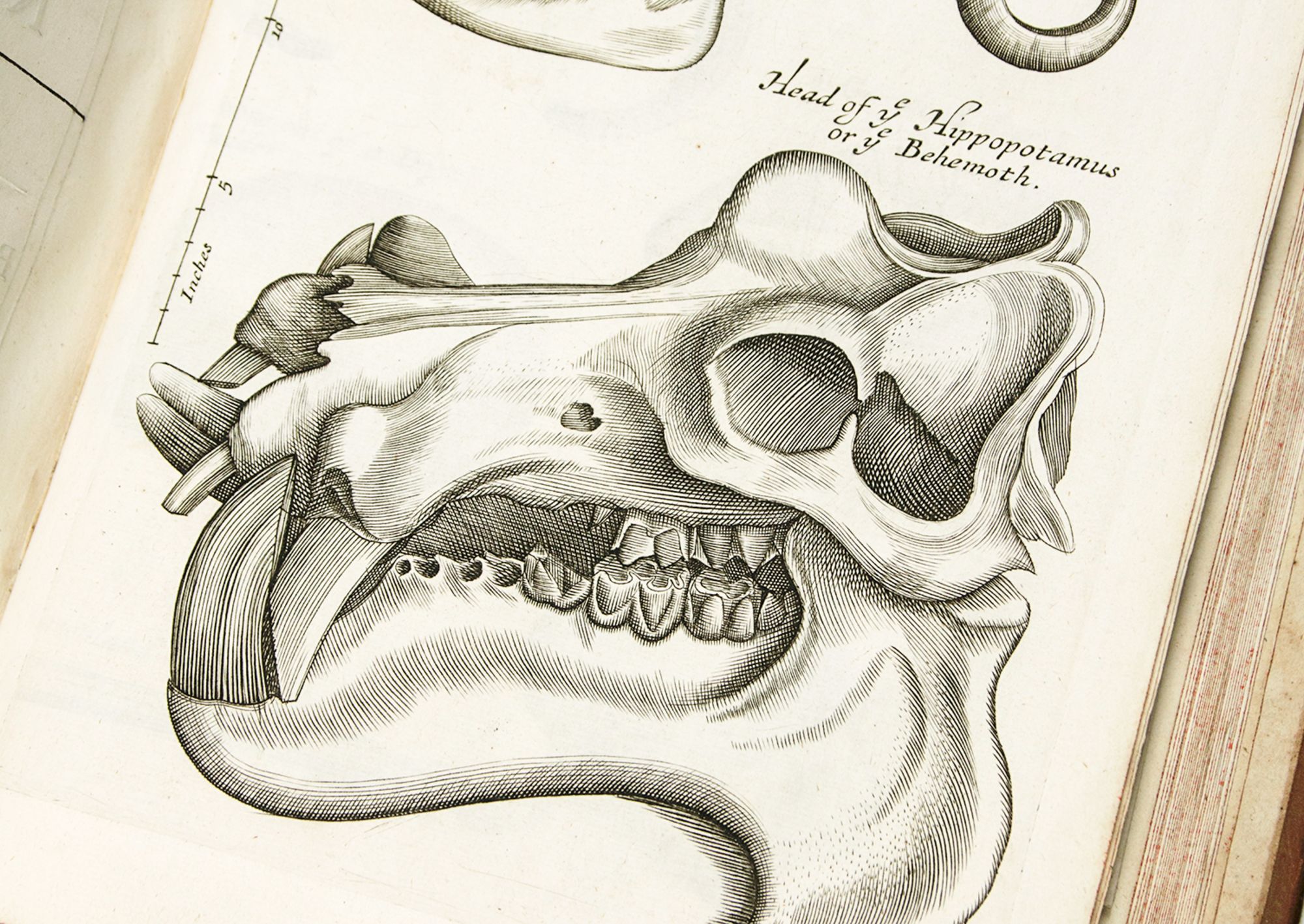
Musaeum Regalis Societatis or a Catalogue & Description Of the Natural and Artificial Rarities Belonging to the Royal Society and preserved at Gresham Colledge. Made By Nehemiah Grew M. D. Fellow of the Royal Society, and of the Colledge of Physitians. Whereunto is Subjoyned the Comparative Anatomy of Stomachs and Guts. By the same Author
Grew, Nehemiah (1641-1712) Including thirty-one full-paged engraved plates (one folding) of the marvelous and exotic subjects of the collections of the Royal Society, and the engraved portrait of the dedicatee Daniel Colwall (d. 1690), the Society's benefactor. Bound in contemporary paneled calf, very nicely rebacked re-cornered, endpapers renewed, some wear to the surface of the boards. An excellent, clean copy. Short worm-trail in the inner margin of the opening leaves, small hole in inner margin of leaf F2. This copy has the usual pen corrections (found in all copies.) Leaf Aa1, Bb1, Pp2 and Pp4 have a few small ink spots (courtesy of the corrector.) Provenance: With the Gaddesden Library bookplate of Sir Walter Halsey (1868-1950). The Gaddesden Library was built 1768 to 1773 by Thomas Halsey, Esq. (1731-1788), in Hertfordshire, England. First edition of the first catalogue of the collections of the Royal Society's collections of ethnographic objects and natural history specimens. At the core of the collection are the donations from the "curiosity cabinets" of the Society's membership, and Robert Hubert's cabinet of "natural rarities", purchased in 1665. The catalogue is the work of Nehemiah Grew, one of the most distinguished scientists of the 17th century, best known for work in plant anatomy, and one of the earliest comparative anatomists to use the microscope. This book also includes his study of the digestive organs, "the first zoological book to have the term 'comparative anatomy' on the title page, and also the first attempt to deal with one system of organs only by the comparative method." (Garrison-Morton 297). The illustrations include a hippopotamus skull, the buttock skin of a rhinoceros, tortoise shells, the skeleton of a crocodile, the sea unicorn, a coconut, fish, bird's nests, shells, insects, and more. American Specimens: Grew describes numerous American specimens, and many are illustrated. There are descriptions of "Virginian money" (a string of hare's teeth), wampum, maize, and a sloth that breeds in Florida. Illustrations include an armadillo, Indian plum stone, coconut, Indian filbert, Butter Nut, and an Indian gourd. "The Sloath. Ignavus sive Pigritia. An Animal of so slow a motion, that he will be three or four days, at least, in climbing up and coming down a Tree. And to go the length of fifty Paces on plain ground, requires a whole day. The Natives of Brasile call him Haii, from his voice of a like sound: which he commonly repeats about six times together, descending, as if one should sing, La, sol, fa, mi, re, ute Whatsoever he takes hold of, he doth it so strongly (or, rather stifly) as sometimes to sleep securely while he hangs at it. See his Description in Clusius, Marggravius, Piso, and others. They all seem to omit the length of his fore feet, which is almost double to that of his hinder. From the shag of his Body, the shape of his Legs, his having little or no Tail, the slowness of his gate, and his climbing up of Trees, as little Bears are us'd to do, he seems to come near the Bear-kind: from which he chiefly differs, In having but three Claws upon a foot. He breedeth principally in Florida and Brasile". (p. 11) "Several sorts of Indian money, called Wampam-Peage. 'Tis made of a sort of Shell, formed into small Cylinders, about a ¼ of an inch long, or somewhat more or less: and so being bored, as Beads, and put upon Strings, pass among the Indians, in their usual Commerse, as Silver and Gold amongst us. But being loose, is not so currant". "A string of Virginian Money. A Row of Teeth in shape like the fore-Teeth of a Hare: all woven together at one end, with brown twisted thread, into one piece ¼ yard long."(p. 370) "Several Spikes or Heads of Mayz or Indian-Wheat; with the Grains, as is not unusual, of three or four colours. The Description of the Plant, with a large Account of its Culture, and Use, were communicated by Mr. Winthrop sometime since Governour of Connecticut in New England: and by me lately published, i- $12,500
- $12,500
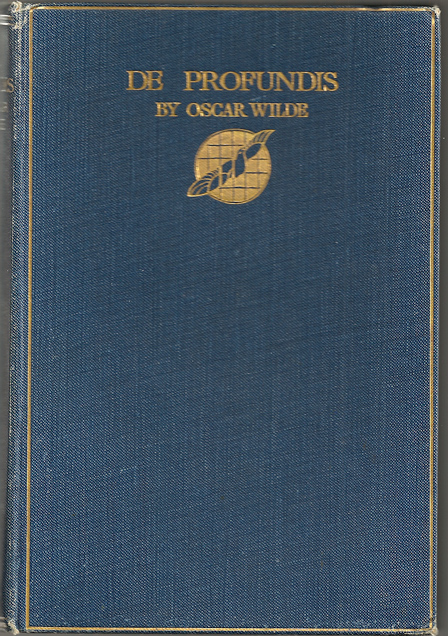
De Profundis
WILDE, Oscar Preface by Robert Ross. Arguably, this item is the single most important copy of the First Edition of Wilde's painful accounting of the effect of social débâcle and imprisonment: the famed Robert Ross copy. The only work Wilde wrote in prison and the last work in prose he ever wrote, the manuscript of which Wilde entrusted to his dear friend, Robert [Robbie] Ross, his sometime lover, most stalwart supporter, and writer of this book's Preface. Avery good copy, albeit quite heavily foxed on the preliminary pages, yet the book's 151 pages following the Preface (plus the Methuen ads following) are quite clean and presentable. .- $950
- $950
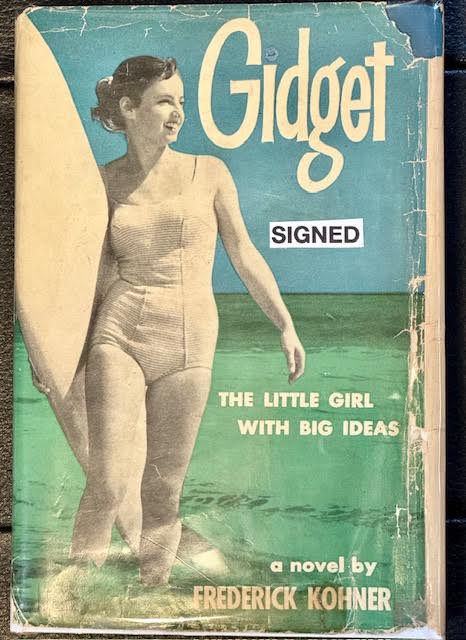
GIDGET The Little Girl With Big Ideas
KOHNER, Frederick Extremely rare true First Edition, First State copy of this treasured cult favorite -- incredibly difficult to find in this condition -- and NEVER seen inscribed and signed by BOTH 'Gidget' as well as the book's author. "To Clare / Best Wishes / "Gidget" as well as: To / Clare E. Butte / Warmest regards and wishes / from the author / Frederick Kohner / Oct. 20th 1957. Copy itself tight, firm, virtually Fine. The highly scarce original pictorial dust jacket is much worn, with random small chips and general use. That said, this scarce First Edition copy of this title is certainly desirable -- and very, very hard to come by.- $2,500
- $2,500
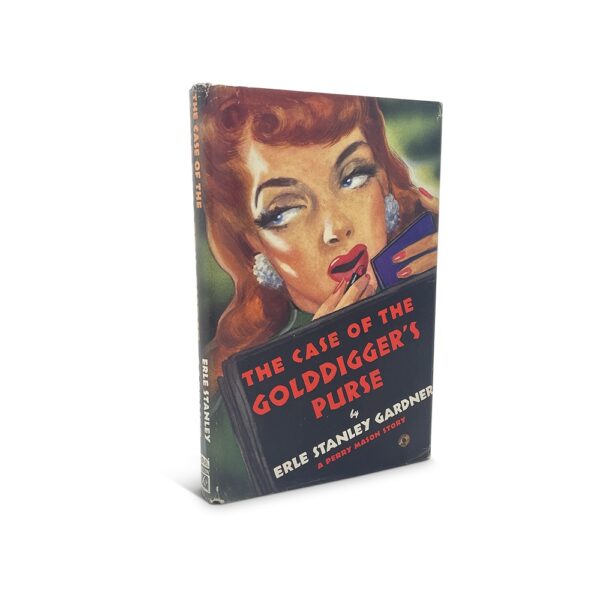
The Case of the Golddigger’s Purse
GARDNER, Erle Stanley 8vo, pp. 218. Original black boards, lettered in black on red to front panel and spine (where the first part of the title is lettered in red on black). Illustrated dust jacket. A fine copy in a near fine dust jacket with just a little fading to spine and the lightest of wear to spine ends. First edition. A Perry Mason title in the almost impossibly prolific Erle Stanley Gardner's bibliography. This is the twenty-sixth title featuring fiction's most famous criminal attorney -- there were eighty-five in all. HUBIN, p. 162- $459
- $459
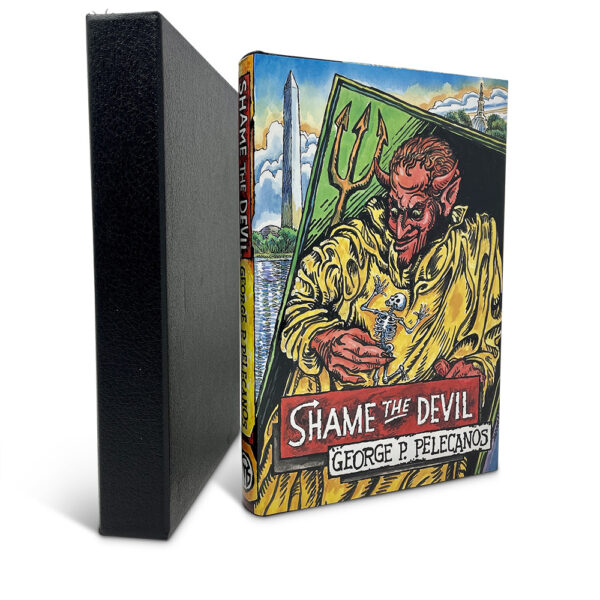
Shame the Devil
PELECANOS, George P. 8vo, pp. 345. Original marbled quarter boards, lettered in gilt to black spine. Black endpapers with devil device in gold. Illustrated dust jacket. Original slipcase. A fine copy in a fine dust jacket and slipcase. Dust jacket design and interior artwork by Joe Servello. First edition, one of 52 quarter bound copies, of a total edition of 452. SIGNED BY THE AUTHOR. The printed limitation states that this is a lettered copy, but no letter has been entered by hand. A fine, unread copy.- $125
- $125

Death notice.
WITTGENSTEIN, Ludwig AN EXCEPTIONAL MEMENTO: THE ANNOUNCEMENT BY HELENE SALZER, BORN WITTGENSTEIN, MARGARET STONBOROUGH, BORN WITTGENTSTEIN, AND PAUL WITTGENSTEIN OF THEIR BROTHER S DEATH IN CAMBRIDGE, ENGLAND, SIX DAYS EARLIER, ON APRIL 29, 1951, AND HIS BURIAL ON MAY 1. In the 1930s and 1940s Wittgenstein conducted seminars at Cambridge, developing most of the ideas that he intended to publish in his second book, Philosophical Investigations. These included the turn from formal logic to ordinary language, novel reflections on psychology and mathematics, and a general skepticism concerning philosophy s pretensions. In 1945 he prepared the final manuscript of the Philosophical Investigations, but, at the last minute, withdrew it from publication (and only authorized its posthumous publication). For a few more years he continued his philosophical work, but this is marked by a rich development of, rather than a turn away from, his second phase. He traveled during this period to the United States and Ireland, and returned to Cambridge, where he was diagnosed with cancer. Legend has it that, at his death in 1951, his last words were Tell them I ve had a wonderful life (Monk: 579) (Stanford Encyclopedia of Philosophy). Born in Vienna into one of Europe s richest families, Ludwig Wittgenstein, his three sisters (a fourth died as a baby) and four brothers received a Catholic education, taught at home in an exceptionally intense environment, and an environment that deeply marked all of them. Ludwig inherited a fortune upon the death of his father in 1913. He initially made some donations to artists and writers, and then, in a period of severe personal depression after the First World War, he gave away his entire fortune to his brothers and sisters. Three of Ludwig s four brothers Hans, Rudi, and Kurt - committed suicide, which Wittgenstein had also contemplated; Hermine died in February 1950, a little over a year before her famous and youngest brother. Ludwig s death is here jointly announced by all of his surviving siblings, Helene, Margaret, whose husband, Jerome Stonborough also had committed suicide 13 years earlier, and Paul. The note mentions Ludwig to have succumbed on Sunday, April 29, after prolonged grave illness, and after having received the last rites. The latter note is of some interest regarding Wittgenstein s faith and relationship with Christianity, which changed over time. Baptized and educated a Catholic, he lost his faith and became an atheist whilst attending the Realschule in Linz as a teenager in 1903-1906. It is also well documented though, that whilst resisting formal religion, he was always sincerely disposed towards religious faith, developing a deepening spirituality with age. The end of the notice prints the siblings respective addresses: Vienna IV, Brahmsplatz 4 for Helene, Vienna III, Kundmanngasse 19, for Margaret, and New York 25, 310 Riverside Drive for Paul, who had fled to America in 1938 to spend the rest of his life there, following charges of racial defilement. This death note was never posted; the original envelope remained unused and is in virgin state. It is thus likely that it remained in the possession of one of Wittgenstein s siblings until it found its way into the open. The number of copies produced was undoubtedly rather small, and sent to close relatives, friends, fellow philosophers, and possibly to members or heads of institutions concerned or involved with Ludwig s work only. Its ephemeral nature much impedes the search for other known examples. Various separate searches on KvK, OCLC, or the catalogue of the Austrian National Library locate no copies though.- $11,158
- $11,158
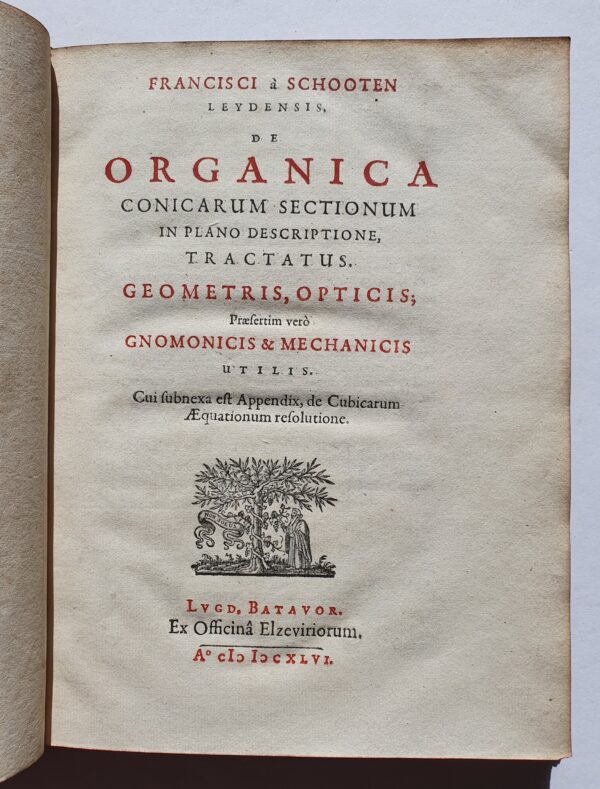
De Organica Conicarum Sectionum in Plano Descriptione, Tractatus. Geometris, Opticis, Prasertime verò Gnomonicis Mechanicis utilis. Cui subnexa est Appendix, de Cubicarum Aequationum resolution
SCHOOTEN, Frans van The de Thou copy of van Schooten's work on conic sections, a work studied by Newton. 'Schooten's first independent work was a study of the Kinematic generation of conic sections (1646). In an appendix he treated the reduction of higher-order binomial irrationals to the form x + √y in cases where this is possible, using a development of a procedure of Stifel's. An interesting problem that Schooten considered was how to construct a cyclic quadrilateral of given sides, one of which is to be the diameter - a problem that Newton later treated in the lectures on Arithmetica universalis (Mathematical Papers, V, 162181). After the death of his father in 1645, Schooten took over his academic duties. He also worked on a Latin translation of Descartes's Géométrie. Although Descartes was not completely satisfied with Schooten's version (1649), it found a broad and receptive audience by virtue of its more carefully executed figures and its full commentary. It was from Schooten's edition of the Géométrie that contemporary mathematicians lacking proficiency in French first learned Cartesian mathematics. Schooten possessed an excellent knowledge of the mathematics of both his own time and earlier periods. Besides being an extraordinarily industrious and conscientious scholar, a skillful commentator, and an inspiring teacher, he was a man of rare unselfishness. He recognized his own limitations and did not seek to overstep them. Fascinated by the personality and ideas of Descartes, he worked hard to popularize the new mathematics; his highly successful efforts assured its triumph. (DSB). This copy stems from the library of Jacques Aguste (II) de Thou, Baron de Meslay, Ambassador to the Netherlands, and 'Président aux Enquêtes', with his gilt arms on covers.- $11,158
- $11,158

Kirchengesanng Teutsch und Lateinisch. In allen Christlichen versamlungen gebreuchlich.
[CHORALES AND HYMNS]. THE SECOND KNOWN COPY OF THIS FINELY PRODUCED PRINTING OF GERMAN CHORALES AND LATIN HYMNS, WITH THE PRINTED LYRICS SIGNIFICANTLY REVISED FROM THE EDITION OF 1557, THE ONLY EARLIER PRINTING. With the beginning of the sixteenth century, European music saw a number of momentous changes. In 1501, a Venetian printer named Ottaviano Petrucci published the first significant collection of polyphonic music, the Harmonice Musices Odhecaton. A. Petrucci s success led eventually to music printing in France, Germany, England, and elsewhere. Prior to 1500, all music had to be copied by hand or learned by ear; music books were owned exclusively be religious establishments or extremely wealthy courts and households. After Petrucci, while these books were not inexpensive, it became possible for far greater numbers of people to own them and to learn to read music From about 1520 through the end of the sixteenth century, composers throughout Europe employed the polyphonic language of [the Franco-Flemish composer] Josquin s generation in exploring musica expression through the French chanson, the Italian madrigal, the German tenorlieder, the Spanish villancico, and the English song, as well as in sacred music. The Reformation and Counter-Reformation directly affected the sacred polyphony of these countries. The Protestant revolution (mainly in Norther Europe) varied in the attitudes toward sacred music, bringing such musical changes as the introduction of relatively simple German-language hymns (or chorales) sung by the congregation in Lutheran services (Rebecca Arkenberg, Music in the Renaissance, the MET, online). Contained here are 84 German chorales, including 31 by Luther, and 64 Latin hymns, including the Magnificat set to 4 voices. VD 16 ZV 21307 (recording a copy at the Staatsbibliothek, Berlin, the only other known copy of this printing).- $15,752
- $15,752
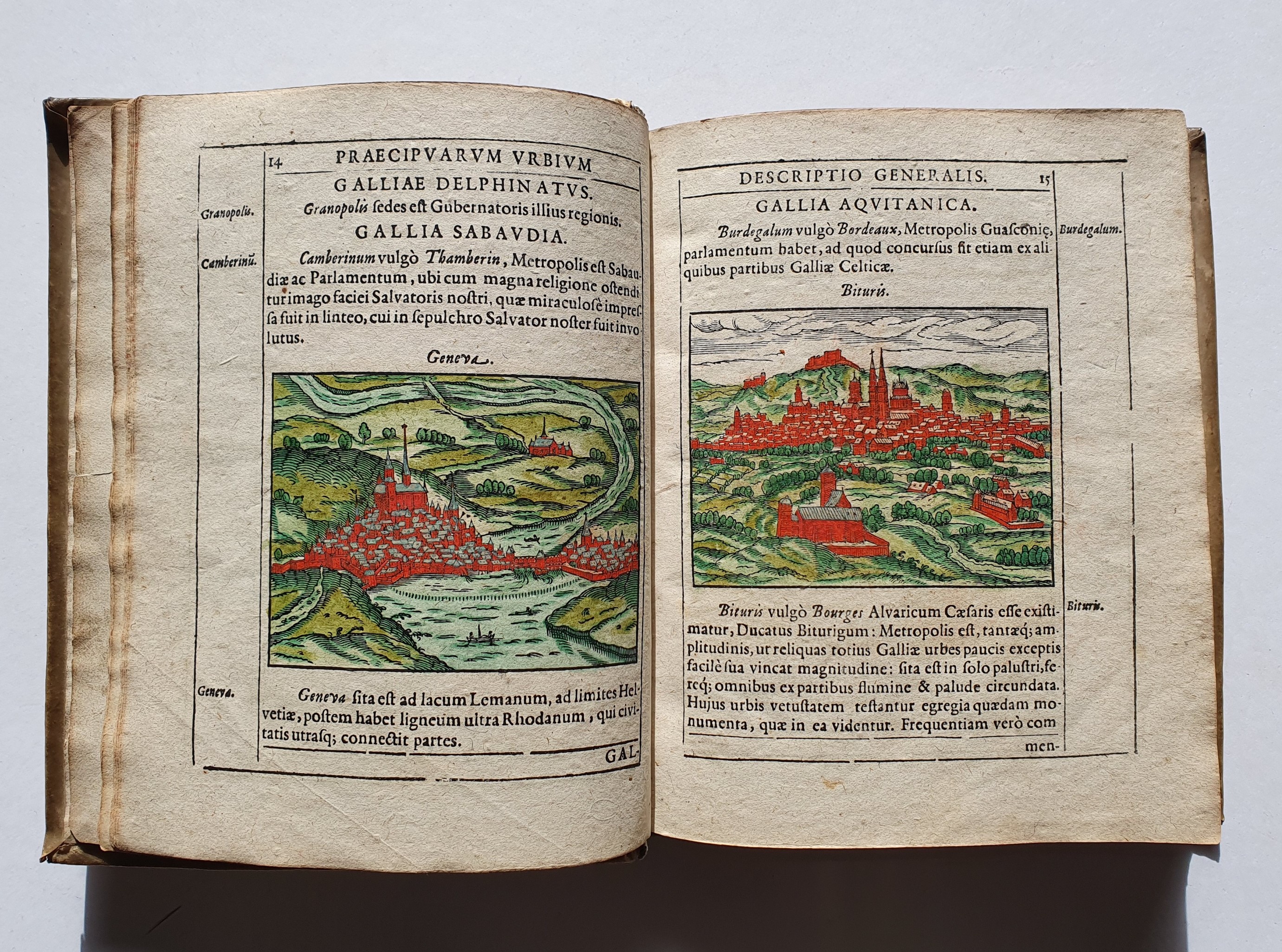
Parvum theatrum urbium sive urbium praecipuarum totius orbis brevis et methodica descriptio.
ROOMEN, Adriaan van [Adrianus ROMANUS] FIRST EDITION, AND A VERY APPEALING COPY WITH THE WOODCUTS HERE FINELY COLOURED, OF THE FAMOUS FLEMISH PHYSICIAN AND MATHEMATICIAN S LATIN TOWN BOOK. Whilst the woodcuts are largely identical to Abraham Saur s German version, but with some omitted or added, this Parvum theatrum urbium is not a Latin edition of the German work published by the same printer in German language. The author of the small town book had died in 1593 and was not available for a Latin edition [and] so the publisher secured A. Romanus from Wurzburg as the author of a Latin text (translated from Fauser). Completely independent from Saur s, van Roomen s text is entirely new, displaying a very different and more succinct approach in his rendition of this geographical work, much reflecting his scientific education and orientation. The work includes 67 European woodcut city views and plans including cuts showing London, Lisbon, Louvain, Antwerp, Brussels, Rouen, Ghent, Lyon, Bordeaux, Paris, Frankfurt, Mainz, Aachen, Heidelberg, Hamburg, Bremen, Hannover, Fulda, Wittenberg, Magdeburg, Nuremberg, Augsburg, Tubingen, Dresden, Worms, Leipzig, Erfurt, Jena, Lubeck, Brunswick, Strasburg, Basel, Geneva, Riga, Rome, Venice, Genova, Prague, Vienna, and Riga, as well as Constantinople, Jerusalem and the tower of Babylon (the final illustration contained). All are in fine colouring, employing red, various shades of green, as well as yellow, purple, and brown, with some delicate and carefully applied heightening in gum Arabic. The work s unillustrated part provides notes on various parts and cities of Russia, Armenia, Assyria, Serbia, Georgia, Albania, Syria, Palestine, Arabia, Persia, Bactria, Afghanistan, Malabar, Ceylon, India, Siam, Cambodia, Korea, China, and Japan, as well as on Java, Sumatra, Borneo, the Moluccas, Japan, and Turkestan. The final pages contain brief descriptions of Florida, New-France, New-Spain, Nova Galicia, Yucatan, Cuba, Brazil, Peru, etc. (Sabin 73000). Adrian van Roomen studied mathematics and medicine in Germany and Italy (he met Christoph Clavius at Rome in 1585, and dedicated his Idea mathematica pars prima, Louvain, 1593, to him). While at Louvain he published the first part of a general work on mathematics and in this he gave the value of pi to seventeen decimal places, an unusual achievement at the time (Smith, History of Mathematics I p. 340). In the same year he obtained a professorship of medicine at Würzburg and subsequently was employed as mathematician of the chapter there. He then went to Prague, was honoured by the Emperor Rudolff II, and travelled to France, where he met Viète. Provenance: early Dutch inscription to title page ( Cornely Deyn (?) Aemstelredamensis ), and a later inscription to front free end-paper. VD 16 R 3024; Adams R 694; Fauser LXIV.- $15,752
- $15,752

Melvin Edwards: Sculpture (Poster for First Solo Exhibition)
EDWARDS, Melvin Exhibition poster (16 x 11 inches) from Melvin Edwards' first solo show, at the Santa Barbara Museum of Art (Mar. 30-May 2, 1965), where he exhibited sculptural works from his Lynch Fragments series. Illustrated after a striking photograph of Edwards with welding glasses. Slight bump to upper corner and faint foldlines, with postage markings to verso; near fine. Archivally-hinged in black lacquer frame (19 x 13 in.).- $1,500
- $1,500
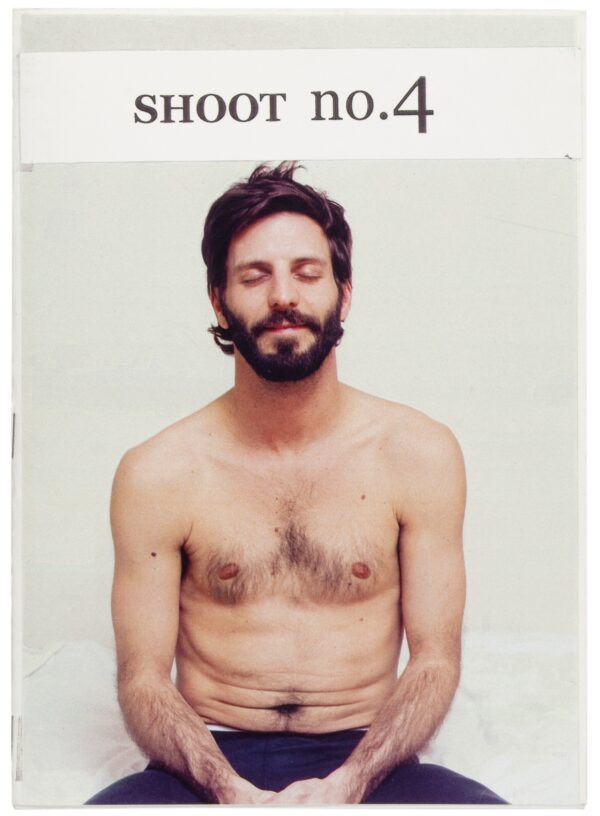
Shoot: No. 4 (with Signed Photo)
SEPUYA, Paul Mpagi Limited Edition. Octavo. Hand-numbered as copy 124/150. The fourth installment of Paul Sepuya's occasional zine, featuring a photoshoot with a topless model named Dean. Interior with 8 black-and-white images and short erotic poem, with covers featuring two additional images in color. (Copy Machine Manifestos, 354-355). Issued with C-print photograph, also numbered 124/150 to verso and SIGNED by Sepuya; dated 2006. Also laid-in, a folded black-and-white offset print, reproducing a doodled-over photo of the model. A fine copy in stapled photo-illustrated wrappers.- $1,200
- $1,200
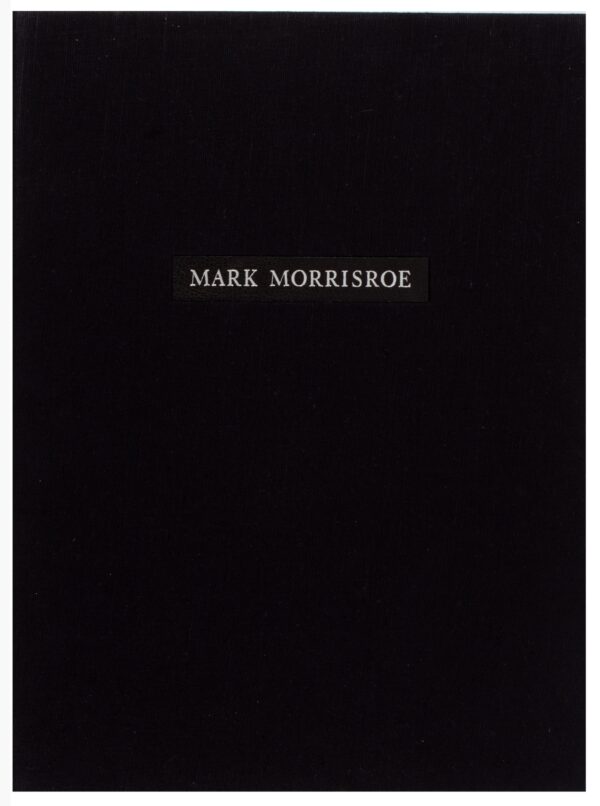
Mark Morrisroe (Portfolio)
MORRISROE, Mark and Nan Goldin First Edition. Folio. A posthumous portfolio of 12 photogravure plates derived from the intimate photographs of Mark Morrisroe (1959-1989); produced by Pat Hearn Gallery (New York), where Morrisroe received his first solo exhibition in 1986. Each of the plates (4.5 x 3.5 in.) printed to handmade sheets (15 x 11.5 in.) and hand-numbered as 11/46 to verso by the Morrisroe Estate. The suite introduced by a statement from Nan Goldin, celebrating her old friend and colleague as "Boston's first punk." The photographs, dating between 1978 and 1986, include two nude self-portraits, portraits of lovers and friends, and a few still lifes. Housed in publisher's cloth clamshell case with leather lettering piece to front panel. A fine copy, including original tissue guards. Scarce, with no OCLC records located. An elegant memorial.- $9,500
- $9,500

Il Disegno della Geografia Moderna de Tutta la Provincia de la Italia.
Giacomo Gastaldi Very rare! The map is engraved by Fabio Licinio. "La piu importante carta dell'Italia apparsa nel XVI secolo". This map represents the most important map of Italy that appeared in the 16th century. It will constitute the cartographic model of the peninsula in Italy for the following century. Almagia defines it as "one of the milestones in the evolution of the cartography of Italy". Gastaldi published the map in 1561, protected by the privilege that he obtained from the Venetian Senate on 29 July 1559. The map contains many improvements over previous maps. Old folds, a few reinforcements at the back, some light spotting in places, very good condition. Copper engraving, printed on paper from two plates, joined. Right plate seems to be trimmed a bit (cf. images in Bifolco-Ronca). Two watermarks: pilgrim in circle. Size (not including margins): 535 x 765mm (21.06 x 30.12 inches). Verso: Blank. Bifolco-Ronca, Tav. 911 State 1 (of 2)- $44,712
- $44,712
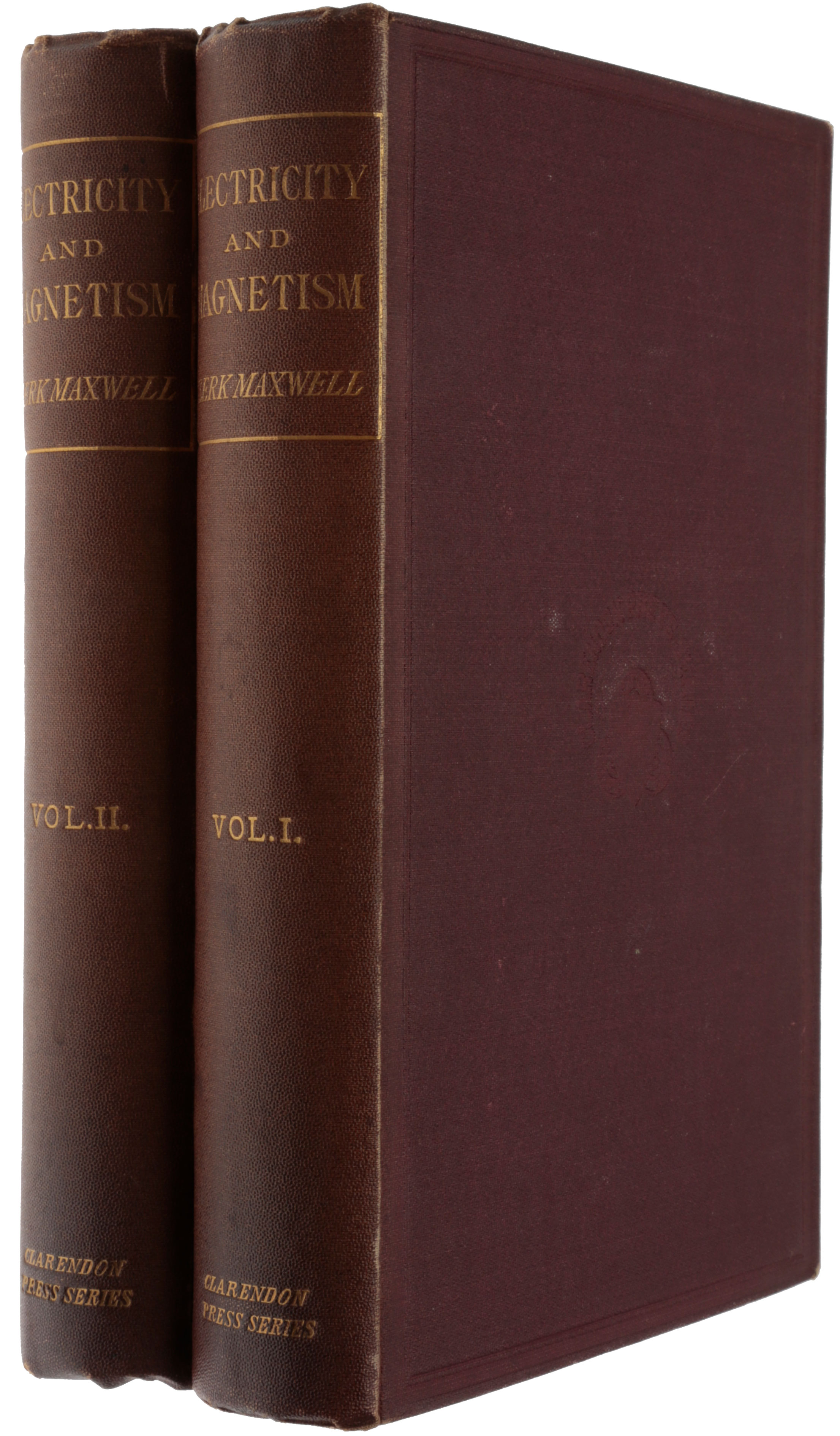
A Treatise on Electricity and Magnetism
MAXWELL, James Clerk PMM 355 - LIGHT AS A FORM OF ELECTRICITY. First edition of Maxwell's presentation of his theory of electromagnetism, advancing ideas that would become essential for modern physics, including the landmark "hypothesis that light and electricity are the same in their ultimate nature" (Grolier/Horblit). "This treatise did for electromagnetism what Newton's Principia had done from classical mechanics. It not only provided the mathematical tools for the investigation and representation of the whole electromagnetic theory, but it altered the very framework of both theoretical and experimental physics. It was this work that finally displaced action-at-a-distance physics and substituted the physics of the field" (Historical Encyclopedia of Natural and Mathematical Sciences, p. 2539). "From a long view of the history of mankind - seen from, say, ten thousand years from now - there can be little doubt that the most significant event of the 19th century will be judged as Maxwell's discovery of the laws of electrodynamics" (R. P. Feynman, in The Feynman Lectures on Physics II (1964), p. 1-6). "[Maxwell] may well be judged the greatest theoretical physicist of the 19th century . Einstein's work on relativity was founded directly upon Maxwell's electromagnetic theory; it was this that led him to equate Faraday with Galileo and Maxwell with Newton" (PMM). "Einstein summed up Maxwell's achievement in 1931 on the occasion of the centenary of Maxwell's birth: 'We may say that, before Maxwell, Physical Reality, in so far as it was to represent the process of nature, was thought of as consisting in material particles, whose variations consist only in movements governed by [ordinary] differential equations. Since Maxwell's time, Physical Reality has been thought of as represented by continuous fields, governed by partial differential equations, and not capable of any mechanical interpretation. This change in the conception of Reality is the most profound and the most fruitful that physics has experienced since the time of Newton'" (Longair). Issues: The Treatise is found in various forms and publisher's bindings. We know of two different cloth bindings, both certainly official publisher's bindings: one with the arms of Clarendon Press blind stamped to the boards; another slightly brighter cloth without the arms (as the offered copy). The copies in the first type of binding (with arms to the boards) seem always to have advertisements for the Clarendon Press bound in the end of volume 2. These adds can be found in two different forms: one with 'just published' at the entry for Maxwell's Treatise itself, and one not mentioning 'just published'. A copy with the just-published-adds seems always to have the short errata slips in volume 1 and 2. Copies with the adds not mentioning 'just published' seems always to have the extended errata leaves, with further corrections than the errata slips. A set in the blind stamped bindings with just-published-adds and short errata slips are usually said to be first issue and a set with longer errata leaves and adds not mentioning 'just published' are usually called third issue. Sets in the brighter publisher's bindings (i.e., without the arms of the Clarendon Press blind stamped to the boards), which in our experience are rarer than the darker blind stamped form, seem always to be without the advertisements for the Clarendon Press in the end of volume 2. These sets can however be found with the shorter errata slips or with the extended errata leaves (as the offered copy). We have so far been unable to determine the exact chronological order in which these various forms were issued. Hence there seems so far to be two first issues (with short errata slips), two second issues (with extended errata leaves), and one third issue (with adds not mentioning 'just-published)'. "Maxwell's great paper of 1865 established his dynamical theory of the electromagnetic field. The origins of the paper lay in his earlier papers of 1856, in which he began the mathematical elaboration of Faraday's researches into electromagnetism, and of 1861-1862, in which the displacement current was introduced. These earlier works were based upon mechanical analogies. In the paper of 1865, the focus shifts to the role of the fields themselves as a description of electromagnetic phenomena. The somewhat artificial mechanical models by which he had arrived at his field equations a few years earlier were stripped away. Maxwell's introduction of the concept of fields to explain physical phenomena provided the essential link between the mechanical world of Newtonian physics and the theory of fields, as elaborated by Einstein and others, which lies at the heart of twentieth and twenty-first century physics" (Longair). The 1865 paper "provided a new theoretical framework for the subject, based on experiment and a few general dynamical principles, from which the propagation of electromagnetic waves through space followed without any special assumptions . In the Treatise Maxwell extended the dynamical formalism by a more thoroughgoing application of Lagrange's equations than he had attempted in 1865. His doing so coincided with a general movement among British and European mathematicians about then toward wider use of the methods of analytical dynamics in physical problems . Using arguments extraordinarily modern in flavor about the symmetry and vector structure of the terms, he expressed the Lagrangian for an electromagnetic system in its most general form. [George] Green and others had developed similar arguments in studying the dynamics of the luminiferous ether, but the use Maxwell made of Lagrangian techniques was new to the point of being almost a new approach to physical theory-though many years were to pass before other physicists fully exploited the ground he had broken . "In 1865, and again in the Treatise, Maxwell's next step after completing the dynamical analogy was to develop a group of eight equations descr- $16,000
- $16,000
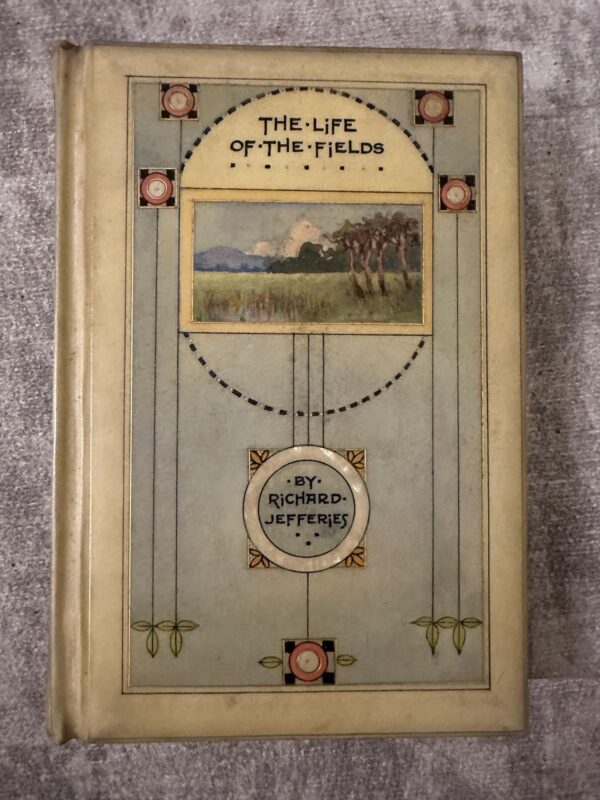
Cedric Chivers “vellucent” binding
Jeffries. R. The Life of the Fields. London, 1908. 8vo. In a Cedric Chivers "vellucent" binding. Some foxing internally. Cedric Chivers (1853-1929) was an innovative English bookbinder and publisher known for his significant contributions to the preservation and restoration of old books. Chivers is particularly renowned for his development of the "vellucent" binding process, where the artwork on a book cover is painted on the underside of transparent vellum, protecting the delicate painting from wear while enhancing the book's aesthetic appeal. Operating out of Bath, England, his work extended beyond craftsmanship to a commitment to library preservation, introducing methods like the "Chivers' Patent" binding which allowed books to lie flat when open, reducing stress on their spines and contributing to their longevity. His dedication to bookbinding and preservation left an enduring legacy in the world of bibliophily and library sciences.- $2,750
- $2,750

1837 Book on Pirates
THOMAS (R.) An Authentic Account of the most Remarkable Events: Containing the lives of the most noted Pirates and Piracies. New York, 1837, Collation pp. (2), 5--298, 12 plates; (2), 5--359, (1), 13 plates. Binding: plain red cloth; internally some general foxing throughout. A Rare American book on Pirates.- $700
- $700
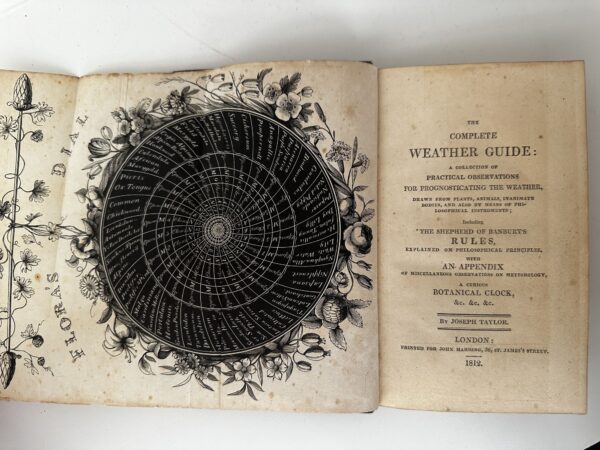
1812 Book on Weather Prediction
[WEATHER PREDICTION]). TAYLOR, JOSEPH. The Complete Weather Guide: a Collection of Practical Observations for Prognosticating the Weather, Drawn from Plants, Animals, Inanimate Bodies, and Also by Means of Philosophical Instruments. London: for John Harding, 1812. First Edition. Small 8vo, 16 x 9.5 cm. Early calf and marbled boards, somewhatrubbed. The beautiful and unusual engraved folded frontispiece of "Flora's Dial". is present explaining when various flowers close or open. RARE. The book contains a compilation of folklore, scientific observations derived from plant studies, and basic knowledge of barometric instruments. Although it was reprinted multiple times in later years, the initial edition was quite rare.- $450
- $450
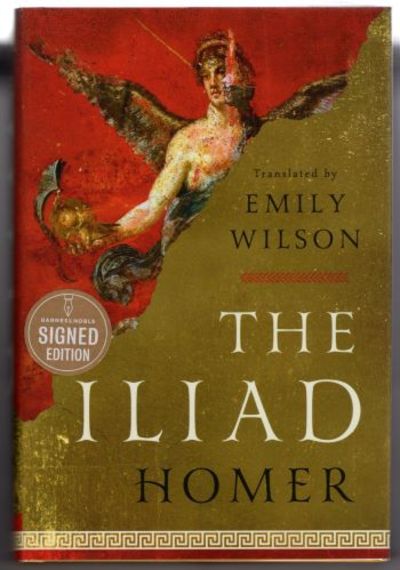
THE ILIAD
Wilson, Emily (trans.) NY, 2023 First edition, first prnt. Signed by Wilson on the title page. Introduction. Translator's Note. Maps. Notes. Genealogies. Glossary. "Signed Edition" sticker on dustjacket front panel and correct isbn sticker on rear panel as issued; one of an unspecified number issued as such. Bumped upper and lower rear board/spine corners (but no corresponding wrinkles on the dustjacket); unread copy in Very Good condition in a Fine dustjacket with an archival cover. Wilson's much heralded second translation of Homer.- $145
- $145
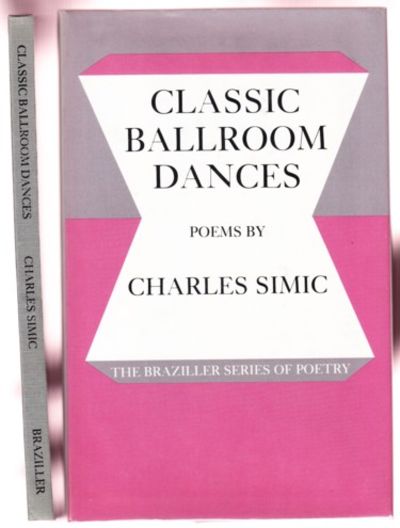
CLASSIC BALLROOM DANCES
Simic, Charles (Annie Dillard) NY, 1980 First edition, first prnt. Association Copy. Inscribed by Simic of the front free endpage to Annie Dillard. "For Annie: More Kid Simic + The Dark Night of History... Charlie Apr 27, 1983 Bow Lake, NH" Dillard's ownership plate affixed to first front free endpage. Tight copy with beginning foxing on the topedge; dustjacket with slightest wrinkle on spine topedge. Very Good condition in a Near Fine dustjacket with an archival cover.- $175
- $175
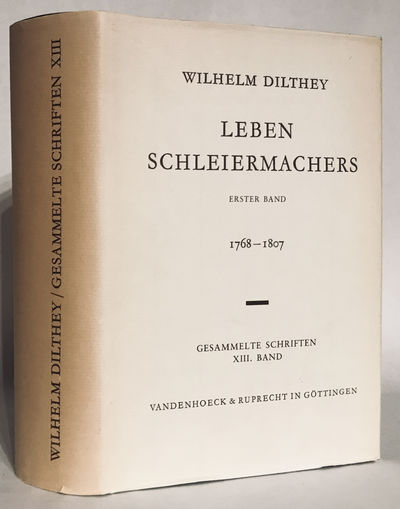
Leben Schleiermachers. Erster Band. Auf Grund des Textes der 1. Auflage von 1870 und der Zusätze aus dem Nachlass herausgegeben von Martin Redeker. Erster und zweiter Halbband in 1 Bd. Wilhelm Dilthey. Gesammelte Schriften. XIII. Band.
Dilthey, Wilhelm; Martin Reeder, Hrsg. Göttingen: Vandenhoeck & Ruprecht (1970)., 1970. Thick, heavy 8vo. xlv, 567 pp.; xxiv, 251 pp. Original gilt-stamped navy blue cloth binding. Text in German. This is a tight, fine book in a near fine DJ with tiny snag front flap; bookplate front pastedown.. 1st Edition. Hardcover. Fine/Dust Jacket Included.- $120
- $120
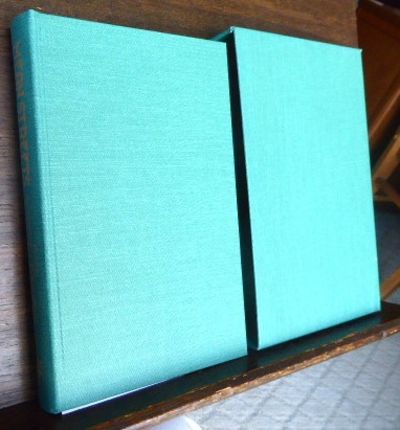
MEAN STREETS, THE SECOND PRIVATE EYE WRITERS OF AMERICA ANTHOLOGY
RANDISI, ROBERT J., EDITED BY New York, 1986 New York: The Mysterious Press, 1986. This is the LIMITED, SIGNED EDITION. All thirteen contributors signed on a special limitation page. 250 copies were published, numbered and signed. This happens to be copy number "B". The letter designation usually denotes a special copy prior to the numbered copies. Twelve original short stories by Max Allan Collins, Wayne D. Dundee, Loren D. Estleman, William Campbell Gault, Sue Grafton, Stuart M. Kaminsky, Rob Kantner, John Lutz, Arthur Lyons, Sara Paretsky, Bill Pronzini, and Dick Stodghell. 230pp. A pristine copy in a custom box, one corner of the box bumped. . Signed by Author. Limited, Signed Edition. Green Cloth. Fine/Fine. Octavo.- $100
- $100

Picturesque Washington
Joseph West Moore Providence, 1884 Providence: J. A. & R. A. Reid, 1884. First Edition. Hardcover. Very Good+/Near Fine. BOOK IS IN VERY GOOD+/NEAR FINE CONDITION WITH BEAUTIFUL BRIGHT GILT PICTORIAL COVER AND SPINE WITH TITLE TO BOTH. BINDING AND HINGES ARE VERY GOOD, NO LOOSE OR MISSING PAGES, PAGES ARE REMARKABLY BRIGHT AND CLEAN, WITHOUT MARKS EXCEPT FOR PREVIOUS OWNER INSCRIPTION TO FRONT FREE PAPER AND NO FOXING. PROFUSELY ILLUSTRATED, 308 PAGES, 10.25"x8". A VERY ATTRACTIVE COPY IN EXCELLENT CONDITION. YOU WON'T FIND A NICER COPY..- $350
- $350
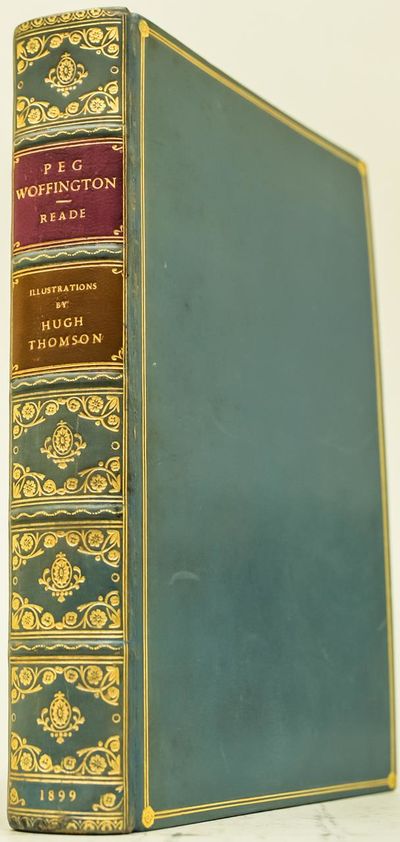
Peg Woffington
Charles Reade London, 1899 London: George Allen, 1899. Limited Edition (Only 200 Copies). Hardcover. Near Fine. Hugh Thomson. BOOK IS IN NEAR FINE CONDITION BEAUTIFULLY BOUND BY FROST IN FULL POLISHED CALF WITH BRIGHT GILT DOUBLE-RULE AND FLORAL PATTERNS TO BOARDS. SIX COMPARTMENTS AND FIVE RAISED BANDS TO SPINE WITH BRIGHT GILT DETAILS AND TITLE. BINDING AND HINGES ARE VERY GOOD WITH BRIGHT GILT END PAGES. NO LOOSE OR MISSING PAGES, PAGES ARE BRIGHT AND CLEAN, WITHOUT MARKS OR FOXING. PROFUSELY ILLUSTRATED, 298 PAGES, BOOK MEASURES 10"x6.75". LIMITED EDITION-200 COPIES PRINTED ON HAND-MADE PAPER. 122 YEARS OLD. A STUNNING BOOK IN REMARKABLE CONDITION..- $600
- $600
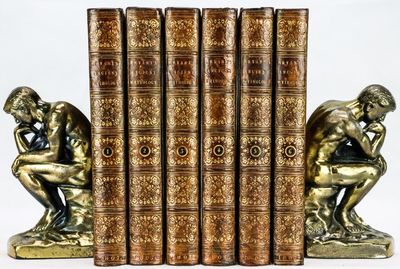
Ancient Mythology
Jacob Bryant London, 1807 London: Janes Nunn, 1807. Hardcover. Very Good. THIS COMPLETE SIX VOLUME SET IS IN VERY GOOD CONDITION BOUND BY THE PUBLISHER IN FULL POLISHED CALF WITH BRIGHT GILT RULE TO BOARDS, SIX COMPARTMENTS AND FIVE RAISED BANDS TO SPINE WITH BRIGHT GILT DETAILS AND TITLE. SOME SCUFFS AND RUBBING TO LEATHER AS SEEN IN PHOTOS. BINDING AND HINGES ARE VERY GOOD WITH MINOR SURFACE RUBBING TO SPINE AND EDGES, MARBLED END PAPERS AND PASTE DOWNS. NO LOOSE OR MISSING PAGES, PAGES ARE WITHOUT MARKS, LIGHT SPORADIC FOXING. ILLUSTRATED WITH 41 PLATES, BOOKS MEASURE 9.5"x6". 213 YEARS OLD. A SCARCE SET..- $1,500
- $1,500
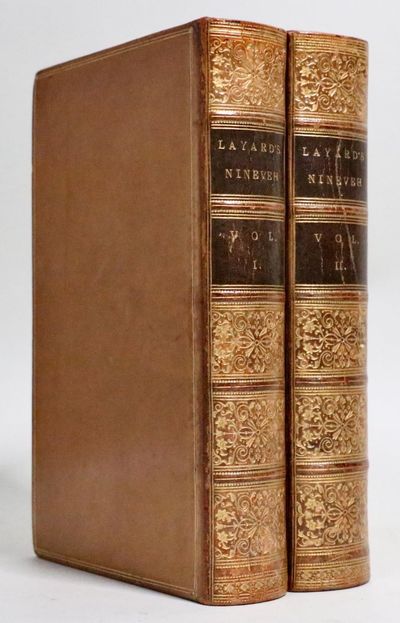
Nineveh and Its Remains
Austen Henry Layard John Murray, 1849. 2nd Edition. Hardcover. Very Good. THIS COMPLETE TWO VOLUME SET IS IN VERY GOOD CONDITION BOUND IN FULL POLISHED CALF WITH BRIGHT GILT RULE TO BOARDS, SIX COMPARTMENTS AND FIVE SHALLOW BANDS TO SPINES WITH BRIGHT GILT DETAILS AND TITLE. SOME LIGHT RUBBING TO LEATHER EXTREMITIES. BINDING AND HINGES ARE VERY GOOD, MARBLED END PAPERS, PASTE DOWNS AND END PAGES. NO LOOSE OR MISSING PAGES, PAGES ARE WITHOUT MARKS SOME LIGHT SPORADIC FOXING. PROFUSELY ILLUSTRATED - NUMEROUS FOLDING PLATES, BOOKS MEASURE 8.75"x5.75". SECOND EDITION, 173 YEARS OLD. AN ATTRACTIVE SET IN GREAT CONDITION.- $900
- $900
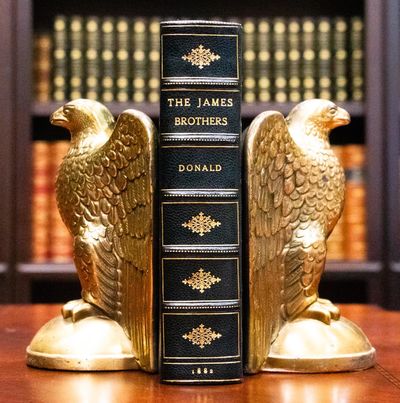
Outlaws of the Border Frank and Jesse James
Jay Donald Forshee & McMakin, 1882 Forshee & McMakin, 1882. First Edition. Hardcover. Near Fine. BOOK IS IN NEAR FINE CONDITION BEAUTIFULLY BOUND BY BAYNTUN IN 3/4 CRUSHED MOROCCO WITH BRIGHT GILT RULE TO BOARDS, SIX COMPARTMENTS AND FIVE RAISED BANDS TO SPINE WITH BRIGHT GILT DETAILS AND TITLE. SOME LIGHT SOILING TO BOARDS. BINDING AND HINGES ARE VERY GOOD, MARBLED END PAPERS, PASTE DOWNS AND BRIGHT GILT TOP END PAGES. NO LOOSE OR MISSING PAGES, PAGES ARE BRIGHT AND CLEAN, WITHOUT MARKS AND MINIMAL FOXING. PROFUSELY ILLUSTRATED, 520 PAGES, BOOK MEASURES 7.5"x5.5". FIRST EDITION, 141 YEARS OLD. A STUNNING EXAMPLE IN SCARCE BAYNTUN BINDING..- $2,000
- $2,000
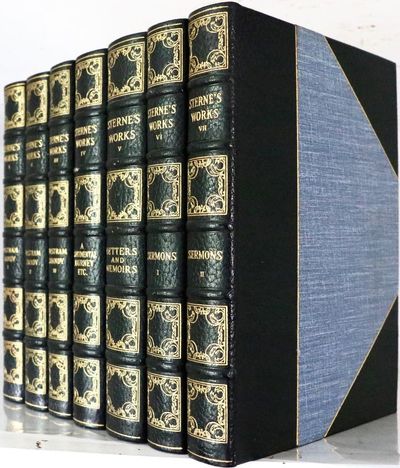
Works of Laurence Sterne
LAURENCE STERNE Houghton Mifflin Company, 1920. Hardcover. Near Fine. George Cruikshank. THIS COMPLETE SEVEN VOLUME SET IS IN NEAR FINE CONDITION IN 3/4 LEATHER WITH BRIGHT GILT DETAILS TO COVERS, SIX COMPARTMENTS AND FIVE RIBS TO SPINE WITH BRIGHT GILT DETAILS AND TITLE. BINDING AND HINGES ARE VERY GOOD, NO LOOSE OR MISSING PAGES, PAGES ARE REMARKABLY BRIGHT AND CLEAN, WITHOUT MARKS AND NO FOXING. BEAUTIFULLY ILLUSTRATED GEORGE CRUIKSHANK, NO PUBLICATION DATE STATED - CIRCA 1920, BOOKS MEASURE 9.5"x6.5". A STUNNING SET BEAUTIFULLY BOUND BY THE RIVERSIDE PRESS, YOU WILL LOVE THIS SET!.- $950
- $950
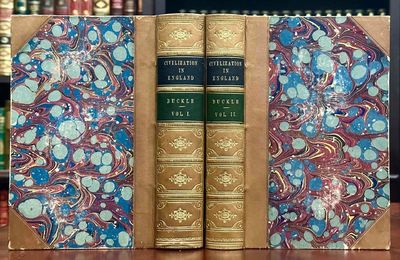
History of Civilization in England
Henry Thomas Buckle New York, 1864 New York: D. Appleton & Company, 1864. Hardcover. Near Fine. THIS COMPLETE TWO VOLUME SET IS IN NEAR FINE CONDITION BEAUTIFULLY BOUND IN 3/4 LEATHER WITH MARBLED BOARDS, SIX COMPARTMENTS AND FIVE RAISED BANDS TO SPINE WITH BRIGHT GILT DETAILS AND TITLE. BINDING AND HINGES ARE IN EXCELLENT CONDITION, MARBLED END PAPERS, PASTE DOWNS AND END PAGES. NO LOOSE OR MISSING PAGES, PAGES ARE BRIGHT AND CLEAN, WITHOUT MARKS AND VERY LITTLE FOXING. BOOKS MEASURE 9.5"x6.25". 159 YEARS OLD. A BEAUTIFUL SET IN EXCELLENT CONDITION..- $650
- $650
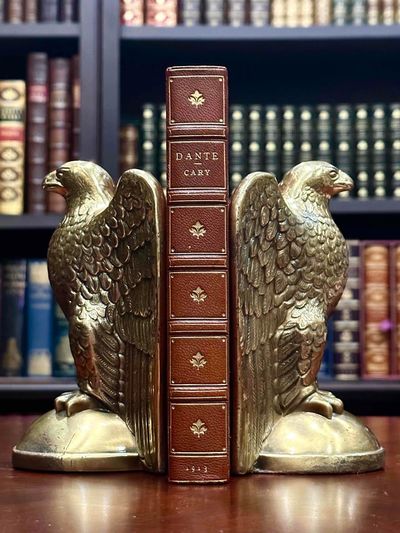
The Vision; or Hell, Purgatory, and Paradise
Dante Alighieri; Trans. by Henry Francis Cary New York, 1913 New York: Henry Frowde, 1913. Hardcover. Near Fine. John Flaxman. BOOK IS IN NEAR FINE CONDITION BEAUTIFULLY BOUND BY MORRELL IN 3/4 CRUSHED MOROCCO WITH BRIGHT GILT RULE TO BOARDS, SIX COMPARTMENTS AND FIVE RAISED BANDS TO SPINE WITH BRIGHT GILT DETAILS AND TITLE. BINDING AND HINGES ARE VERY GOOD, MARBLED END PAPERS, PASTE DOWNS AND BRIGHT GILT TOP END PAGES. NO LOOSE OR MISSING PAGES, PAGES ARE BRIGHT AND CLEAN, WITHOUT MARKS AND NO FOXING. PROFUSELY ILLUSTRATED WITH IN TEXT WOOD CUTS, BOOK MEASURES 7.5"x5.25". 110 YEARS OLD. A BEAUTIFUL EXAMPLE IN SCARCE MORRELL BINDING..- $650
- $650
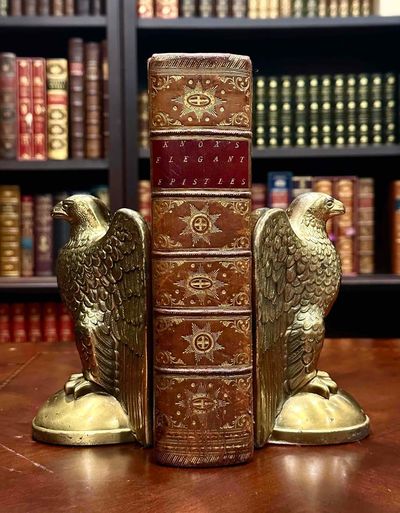
Elegant Epistles
Vicesimus Knox London, 1794 London: T. Longman, 1794. Hardcover. Very Good+. THIS BOOK IS IN VERY GOOD+ CONDITION BEAUTIFULLY BOUND IN FULL POLISHED TREE CALF WITH SIX COMPARTMENTS AND FIVE RAISED BANDS TO SPINE WITH BRIGHT GILT DETAILS AND TITLE. BINDING AND HINGES IN EXCELLENT CONDITION. NO LOOSE OR MISSING PAGES, PAGES ARE BRIGHT AND CLEAN, WITHOUT MARKS AND WITH VERY LITTLE FOXING. BOOK MEASURES 9 3/8"x6.25". 229 YEARS OLD. A BEAUTIFUL EXAMPLE IN EXCELLENT CONDITION..- $750
- $750
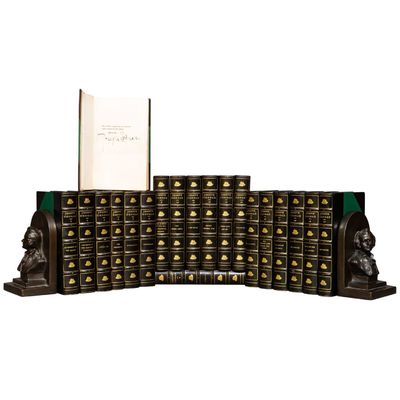
The Works of Joseph Conrad
Joseph Conrad John Grant, 1925. Hardcover. Near Fine. THIS COMPLETE 20 VOLUME SET IS IN NEAR FINE CONDITION BEAUTIFULLY BOUND IN 3/4 LEATHER WITH BRIGHT GILT RULE TO BOARDS, SIX COMPARTMENTS AND FIVE RAISED BANDS TO SPINE WITH BRIGHT GILT DETAILS AND TITLE. BINDING AND HINGES ARE VERY GOOD, MARBLED END PAPERS, PASTE DOWNS. NO LOOSE OR MISSING PAGES, PAGES ARE BRIGHT AND CLEAN, WITHOUT MARKS AND MINIMAL FOXING. BOOKS MEASURE 8.25"x5.5". LIMITED EDITION #126 OF 1000, SIGNED BY JOSEPH CONRAD. 97 YEARS OLD. A STUNNING SET IN REMARKABLE CONDITION.- $8,500
- $8,500
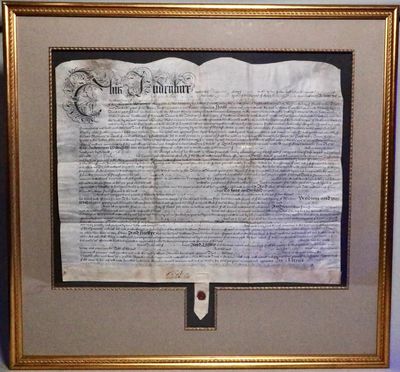
RARE 1682 Colonial William Penn Signed Document
1682. No Binding. Important and Rare 1682 Colonial William Penn Land Indenture between William Penn to Quaker Joseph Potter for 250 acre of land. Signed in full by Penn. Frame measures 36" wide x 34" tall and includes JSA Letter of Authenticity..- $9,000
- $9,000
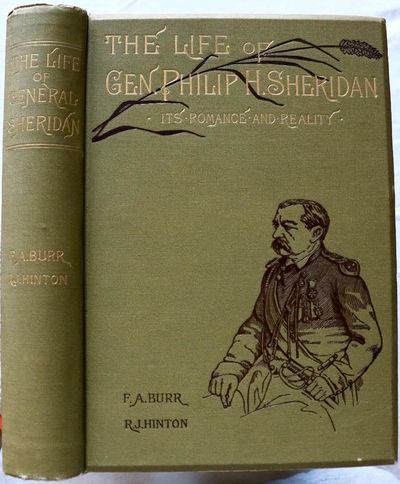
The Life of Gen. Philip H. Sheridan
Frank A. Burr & Richard J. Hinton Providence, 1888 Providence: J. A. & R. A. Reid, 1888. Hardcover. Near Fine. BOOK IS IN NEAR FINE CONDITION WITH PICTORIAL COVER, BRIGHT GILT TITLE TO COVER AND SPINE. BINDING AND HINGES ARE VERY GOOD, DECORATIVE END PAPERS AND PASTE DOWNS. NO LOOSE OR MISSING PAGES, PAGES ARE REMARKABLY BRIGHT AND CLEAN, WITHOUT MARKS AND NO FOXING. PROFUSELY ILLUSTRATED, 445 PAGES, BOOK MEASURES 9"x7". 129 YEARS OLD. A VERY NICE EXAMPLE OF THIS SCARCE BOOK, YOU WON'T FIND A NICER COPY!.- $350
- $350
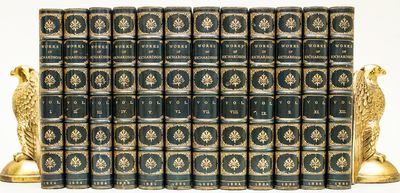
The Works of Samuel Richardson
Samuel Richardson London, 1884 London: Henry Sotheran & Co, 1884. Limited Edition #17 of 250. Hardcover. Near Fine. THIS COMPLETE TWELVE VOLUME SET IS IN NEAR FINE CONDITION BEAUTIFULLY BOUND IN 3/4 CRUSHED MOROCCO WITH BRIGHT GILT DOUBLE-RULE AND MARBLING TO BOARDS, SIX COMPARTMENTS AND FIVE RAISED BANDS TO SPINE WITH BRIGHT GILT DETAILS AND TITLE. BINDING AND HINGES ARE VERY GOOD, MARBLED END PAPERS, PASTE DOWNS AND TOP EDGES GILT. NO LOOSE OR MISSING PAGES, PAGES ARE BRIGHT AND CLEAN, WITHOUT MARKS OR FOXING. 8vo, BOOKS MEASURE 8.75"x5.75". LIMITED EDITION-ONLY 250 COPIES OF WHICH THIS IS NUMBER 17, 137 YEARS OLD. AN ATTRACTIVE SET IN REMARKABLE CONDITION..- $2,500
- $2,500
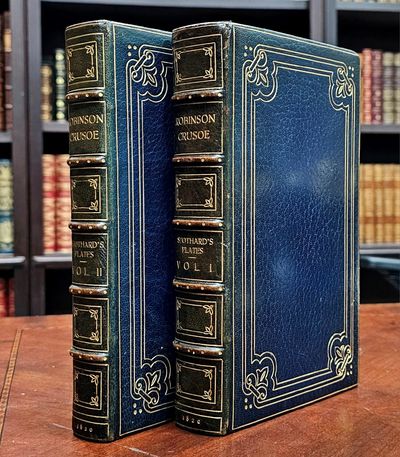
Robinson Crusoe
Daniel Defoe London, 1820 London: T. Cadell and W. Davies, 1820. Hardcover. Near Fine. Thomas Stothard. THIS COMPLETE TWO VOLUME SET IS IN NEAR FINE CONDITION BEAUTIFULLY BOUND BY BAYNTUN IN FULL CRUSHED MOROCCO WITH BRIGHT GILT RULE TO BOARDS, SIX COMPARTMENTS AND FIVE RAISED BANDS TO SPINE WITH BRIGHT GILT DETAILS AND TITLE. SMALL AMOUNT OF WEAR TO LEATHER EXTREMITIES. BINDING AND HINGES ARE VERY GOOD, MARBLED END PAPERS, PASTE DOWNS AND BRIGHT GILT END PAGES. NO LOOSE OR MISSING PAGES, PAGES ARE BRIGHT AND CLEAN, WITHOUT MARKS EXCEPT FOR PREVIOUS OWNER INSCRIPTION TO REAR FREE PAPER AND FRONT FREE PAPER - SUPPOSEDLY FROM THE LIBRARY OF FAMOUS CHILDREN'S AUTHOR EUGENE FIELD WITH HIS INSCRIPTION. MINIMAL FOXING. PROFUSELY ILLUSTRATED BY THOMAS STOTHARD, BOOKS MEASURE 9"x5.75". 203 YEARS OLD. A BEAUTIFUL SET IN SCARCE BAYNTUN BINDING..- $2,000
- $2,000

Two Miniature Artist’s Books: Love. Hate
Groh, Klaus Two small unpaginated artist's books, signed and dated by Groh. Each booklet 3 7/8 x 2 3/4 inches. Side-stapled gray cardstock, titles handwritten in pencil to front covers and Groh's name rubber-stamped, hand-signed and dated '87 in pencil to back covers. Extremely light soiling to covers, overall excellent. N.p, 1987. Klaus Groh (b. 1936) is a German artist and author who helped bring Mail Art from America to Europe and established an international Mail Art network. He directed the Micro Hall Art Center and the cabaret Literaturium as well as the International Artists' Cooperation (I.A.C.), the latter of which he ran from 1969 to 1990. These two miniature artist's books, titled "Love" and "Hate", are comprised of cut-up pages from a German telephone book, including some personal names and phone numbers as well as advertisements for businesses. They are unpaginated, each comprised of approximately 48 double-sided leaves. These two volumes are possibly unique; as of April 2024, there were no listings for either booklet on OCLC.- $650
- $650
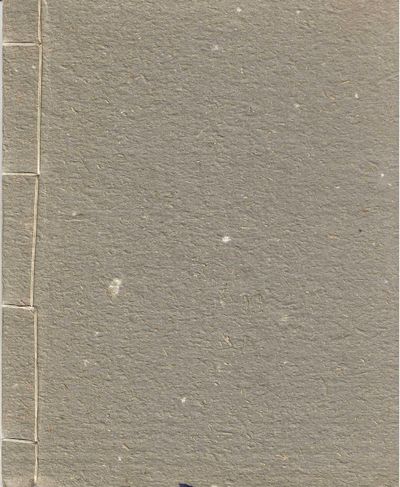
TEN PARABLES
Knott, Bill. (Frank Bidart.) Boston, 1997 Boston: The Author, 1997. 1st edition, original gray handmade stiff paper covers, stitched binding. Illustrated throughout with drawings by the author. The colophon page states: "This book was made by the author / June 1997". The book is inscribed by Knott on the title page: " -- To One of the Few Masters, / Frank Bidart, / from one of the many / disciples, / Bill Knott / -- May '97" in black ink. Bidart won the Pulitzer Prize for poetry (2018) and the National Book Award for poetry (2017). A nice association copy between these two poets.- $125
- $125
![Graficheskie kompozitsii [Graphic compositions]](https://rarebookinsider.com/wp-content/uploads/2024/05/1603772582.0.l.jpg)
Graficheskie kompozitsii [Graphic compositions]
Vekstein, Leonid Small volume of movement study drawings in a Constructivist and Cubist-influenced style. Oblong octavo (6 3/4 x 10 3/8 inches). Original printed wrappers. Light browning, minor soiling to covers, small areas of wear and loss along edges and spine, some staining near staples, light scattered spotting to interior, overall very good. Leningrad: n.p., 1929. Little is known about the artist who created these images. However, there is a three-page introduction that precedes the 48 figure studies titled "Synthesis of Form, Dynamics of Action, Rhythm of Lines", in which Vekstein discusses the sense of movement he instilled into some of his drawings. He mentions the curves of the figures of laundresses echoing the curves of the iron and the fabric, or the swing of the shovel, scythe, or hammer by a worker. Other rounded lines evoke music, speed, or vibration. The studies are clearly taking inspiration from Constructivist and Cubist art in their style and interpretation. A fascinating sketchbook; as of April 2024, we could find no records of this work on OCLC.- $600
- $600
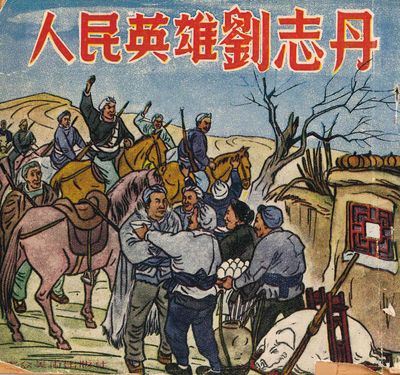
Ying Ying de Zao Yu (Ying Ting’s Misfortune)
Keyang, Yang Small Chinese comic-book style booklet. Square 16mo (4 3/4 x 5 1/4 inches). Original pictorial wrappers; 4, 96 pp. Light wear to corners; some toning to leaves; a few losses to corners of last few leaves (pp. 81-96), with no loss to images; paper brittle; overall good. Shanghai (Da zhong mei shu chu ban she/The Masses Artistic Publishing Company) 1949. Small Chinese propaganda booklet in "lianhuanhua" or comic book format, telling the political morality story of Ying Ying, the heroine who grew up in "suffering and depravation" but finds new life in the People's Liberation, with bold black-and-white woodcut illustrations by Keyang to every page. Yang Keyand (1914-2010) studied wood engraving with various masters, and in the 1940's participated in anti-Japanese activities and joined the All-China Wood Engraving Association Movement. During the Creative Print Movement in 1930s China, the woodblock and its ease of mass-production of images was repurposed to serve new political purposes. Many artists created prints with clear nationalistic messages, while others made images of political protest. The outbreak of the Sino-Japanese War in 1937 united these two themes in the work of many artists. Very scarce; as of April 2024, WorldCat locates only two holdings in North America.- $950
- $950
